News
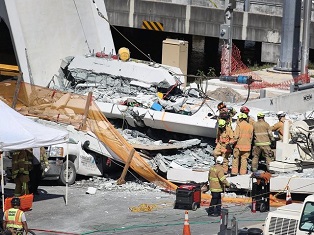
The Sweetwater University City Pedestrian Bridge collapse at Florida International University is the latest civil engineering failure making headlines around the world.
Figg Bridge Engineers discussed a crack that had formed on the new bridge hours before its demise, but “concluded there were no safety concerns and the crack did not compromise the structural integrity of the bridge.”
Despite these assertions it did collapse and caused six fatalities and further injuries. Vehicles were pancaked underneath the rubble, as the photograph here depicts.
Lead engineer on the project W. Denney Pate had sent a voice mail to the Transportation Department; he reported the “cracking” that was observed on the “north end” of the bridge. The voice mail was sent two days before the bridge came crashing down.
Pate did say, in his professional opinion, the cracking “from a safety perspective” was not something they were concerned about. The cracking did not indicate that a collapse would follow. The engineering firm even did a stress test a few days before the collapse. All tests performed failed to raise any urgent red flags.
A civil lawsuit has been filed for gross negligence, in an attempt to hold the design-construction firm to account. The bridge was a US$14.2 million project. The National Transportation Safety Board is currently investigating the case, and also keeping a close eye on other new bridges across the country.
How was the bridge made?
The doomed bridge in Florida was being designed and constructed using a method known as Accelerated Bridge Construction (ABC). The process makes use of prefabricated materials that are brought on-site and then assembled - the end product here was a pedestrian bridge.
In fact Florida International University has an entire center dedicated to the rapid bridge building practice: the Accelerated Bridge Construction University Transportation Center.
The ABC method, used for quicker bridge builds, is also renowned for its cost effectiveness. And the bridges are usually robust - a Category 5 hurricane shouldn’t have the capacity to take one down apparently. An added benefit: roads can remain open during the building process. It was this that proved fatal!
The ABC method has been proving popular around the world, but is now, understandably, receiving greater scrutiny. The National Transportation Safety Board in the US is currently investigating the case (and keeping a close eye on other new bridges across the country). The investigation will drill down into the specific methods used during an ABC build in an effort to determine what the exact cause or causes were for this catastrophic failure.
America needs to monitor current civil engineering structures whilst also focusing on the ‘in-need-of-maintenance’ infrastructure that has been receiving stark criticism in the last few months.
Earlier this year aging infrastructure in the US took center stage when data generated from the Department of Transportation revealed that more than 54,000 bridges in America are currently structurally deficient. The information suggested that one in three bridges is in need of repair, including three interstate highway bridges.
This is essentially good news for structural and civil engineers interested and experienced in bridge design, construction and maintenance and based in the US.
Works Cited
Dearen, Jason. “Rapid Building Technique Gets Scrutiny After Bridge Collapse.” Popular Mechanics, Popular Mechanics, 18 Mar. 2018, www.popularmechanics.com/technology/infrastructure/a19472387/rapid-building-technique/.
Self, Zac, and Associated Press. “Engineer Reported Cracking before Miami Pedestrian Bridge Collapsed.” 10News, 17 Mar. 2018, www.10news.com/news/engineer-reported-cracking-before-miami-pedestrian-bridge-collapsed.
Palm Island

In 2001, there was nothing off the coast of Dubai except for shallow gulf water. However, the city was becoming overpopulated quickly. To solve this problem, local real estate conglomerate Nakheel Properties used GPS precision to shape 94 million cubic metres of sand into a 17-frond palm tree-shaped island. Sixteen quarries throughout the UAE were dredged for rock, which forms a breakwater around the island to protect it from wind and waves. It took a decade for Palm Jumeirah to be fully completed, although residents began moving to the island in 2008. The trunk is made up of luxury hotels and malls; the fronds are lined with mansions. A six-lane underwater tunnel allows people to travel to the island from the mainland and the Middle East’s first monorail travels the length of the island. Two other islands are currently under construction.
Burj Khalifa
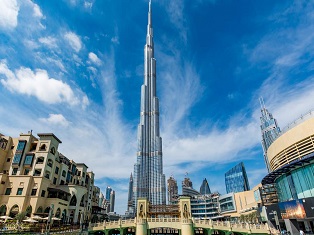
Officially the tallest free standing building in the world, this skyscraper is 828 metre high and has 163 stories. The biggest challenge engineers faced were strong winds, so they conducted over 40 wind tunnel tests, not only to determine how the building would be affected, but to ensure the safety of the cranes used to construct it. Built in Dubai, UAE in 2010, the building changes width as it gets taller in a bid to “confuse the wind,” according to global engineering firm SOM, who created the structure. This means wind vortexes cannot form, as they encounter a new shape at each tier of the building. The building has been engineered to withstand earthquakes and other natural disasters.
Kansai Airport
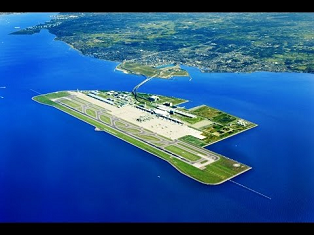
Located in Osaka, Japan, this was the first airport to be built on an artificial island. The project was created as a solution to overcrowding, as the city was too small to fit an airport on the mainland. One of the biggest challenges engineers faced was the clay found in the seafloor they intended to build on – it retains too much water to be a reliable foundation. To combat this, engineers utilised 1.2 million sea drains, a new technique used for sea-based stabilisation. Tubes were driven deep within the clay, filled with millions of tons of sand, and then removed. The columns of sand still act as drains within the clay, to stop the foundation becoming saturated with moisture and moving. 48,000 concrete tetrahedrons were stacked upon the stabilised seabed, with each one weighing 181 tonnes. Nearby mountains were excavated and approximately 161 million cubic tonnes of earth were poured into the gaps. It took three years for the seawall and base to be completed, before construction could begin on the airport itself.
The airport is an architectural wonder, built to reduce environmental impact and save money – blade-like deflectors line the ceiling, channelling air through the building and acting as a passive air conditioning system. Completed in 1994, it took three years and saw over 10,000 workers contribute to its construction. The island is 4 kilometres by 2.5 kilometres and became the world’s most expensive civil engineering project, costing US $20 billion.
Tokyo Sky Tree
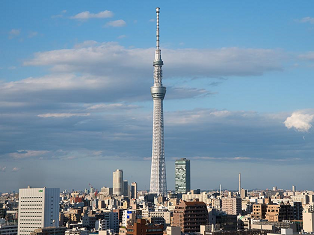
Engineers tasked with the construction of the 634 metre high-rise building faced many challenges while building Japan’s tallest building. They had to take into account not only the typhoons that strike Tokyo every summer, but also potential earthquakes as it is built on an active fault. Structurally, it features a reinforced concrete central column, which is separate from the outside steel frame – an adaptation of the design often seen in pagoda temples. Traditional Japanese building technique shinbashira was utilised, which sees the central column reduce sway by counterbalancing seismic waves.
Channel Tunnel
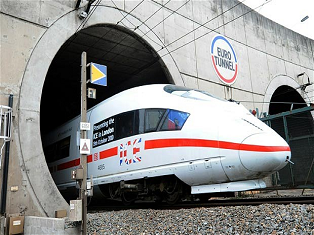
This 50.5 kilometre tunnel features the longest undersea portion in the world, coming in at 37.9 kilometres. Completed in 1994 after six years of construction, it cost approximately US $21 billion and required much problem solving from engineers. For example, they needed to ensure passenger safety, in case of a fire within the tunnel. So, engineers constructed a third, smaller tunnel in between the two full-sided tunnels, to act as an escape route during emergencies. There are also a number of passages that allow the trains to cross-over onto the other track. Eleven boring machines were used to dig the tunnel, collectively weighing over 12,000 tonnes – each one was as long as two football pitches.
Construction saw collaboration between British and French engineers, who had a competition to see who could reach the centre of the tunnel first: the British won. 13,000 workers were employed at the height of construction, and 10 people were killed while building the tunnel. The average depth of the tunnel is 50 metres below sea level, with the lowest point 75 metres down. The Channel Tunnel was included in the American Society of Civil Engineer’s “Seven Wonders of the Modern World” list.
Panama Canal
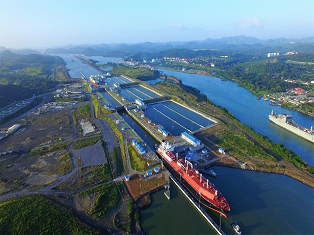
The French originally started this project back in 1880; however they failed because of poor design and high mortality from diseases such as yellow fever and malaria. So, the US took over and redesigned the endeavour in 1904, officially completing the project in 1914. Measuring 77 kilometres, this canal connects the Pacific and Atlantic oceans, allowing easier passage for ships. There were many challenges for engineers to overcome, such as the landmass being above mean sea level due to mountainous terrain, dense jungle, removing rocks and soil, and differences in tides. The Europeans believed canals should be built at sea level; however this would have involved much excavation and cost millions of dollars more. The Americans decided to utilise locks, which would raise and lower ships into the placid waters of the canal. Dams and spillways meant the water in this canal was better regulated than a strait in between two bodies of water, mitigating the issues brought on by the differences in tides.
Millau Viaduct
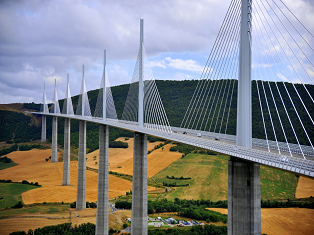
At 343 metres high, the Millau Viaduct is the world’s tallest bridge – it’s even taller than the Eiffel Tower. 18,000 tonnes of concrete were used to build its seven piers and the bridge cost a total of US $524 million to construct. The biggest marvel of this bridge is the short construction span of only three years from 2001-2004; builders were placed under enormous pressure to build it in less than four years; otherwise the French government would fine them US $30,000 per day. The bridge spans 2460 metres from France to Spain and carries between 10,000 and 25,000 cars per day.
Grand Canyon Skywalk
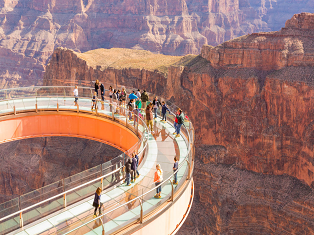
This glass bridge allows tourists to walk out onto thin air, 1219 metres above the Colorado River in the Grand Canyon. Its construction required over 453,000 kilograms of steel and 37,000 kilograms of glass to complete, with the total cost coming to US $40 million. Engineers had to undergo rigorous testing to ensure the structure could withstand the strong winds that come through the canyon; it has been designed to absorb vibrations. The foundation consists of eight support beams and the skywalk was assembled onsite, with the welding of the bridge taking four months to complete. A manipulator was designed to lift the 46 glass panels, each weighing 816 kilograms, into place. Three tuned mass dampers, which were specifically calibrated to meet the wind and weight requirements, were placed inside the horseshoe frame to make the bridge structurally sound.
Venice Tide Barrier
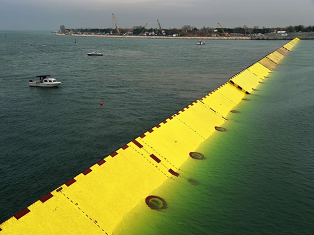
Despite construction beginning in 2003, this barrier is not yet complete. However the last of the giant floodgates designed to protect Venice from rising sea levels were built by a Croatian engineering firm earlier this year. In total there will be 78 gates forming four barriers at the three lagoon inlets of Lido, Malamocco and Chioggia. Each gate weighs 272 tonnes and measures 30 metres wide by 20 metres high, and five metres thick. The Electromechanical Experimental Module (abbreviated to MOSE in Italian) consists of over 18,000 tonnes of built-in steel, and is expected to have a 100 year lifespan.
Engineers have been faced with a number of challenges during this project’s construction, such as lowering the 23,000 tonne foundation into a lagoon. MOSE’s purpose is to only be deployed when it is necessary to do so; it will not stop tidal flow into the lagoon or cut Venice off from the ocean. The moveable barriers will sit beneath the lagoons surface during calm weather, allowing the gates to fill with water. However, when the tide rises, the water will be pumped out of the gates and replaced with air, so they rise to the surface and form a barrier capable of stopping water surges as high as 2.7 metres. This project will cost approximately US $6.5 billion in total.
Itaipu Dam

The world’s second-most powerful dam is located on the border of Brazil and Paraguay on the Paraná River. It was constructed in 1984, as a solution to projected energy crisis in Brazil due to its rapid population growth. The government decided to utilise the vast expanse of water surrounding Brazil and turn it into hydroelectricity. The dam took seven years to construct and provided jobs to 40,000 construction workers during this time. It generates enough energy to service 93% of Paraguay and 20% of Brazil.
The most challenging part of this project for engineers was changing the course of the Paraná River before construction could begin. It took three years for them to carve a 2 kilometre long, 91 metre deep channel for the river to divert through – fifty million tonnes of earth and rock had to be moved in the process. The dam wasn’t to be supported by any physical or natural features, so it had to weigh at least 61 million tonnes to withstand the water pressure, which was estimated to be the equivalent of 4000 bulldozers.
Trans-Siberian Railway
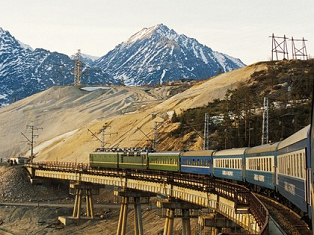
The world’s longest railroad took 25 years to construct. Completed in 1916, the Trans-Siberian Railway spans Russia from east to west for 9,198 kilometres; even today it’s the only way to cross the country, aside from flying. The idea was conceived by Tsar Alexander III; however the majority of its construction took place during Tsar Nicholas II’s reign, and stemmed from the fear of losing trade prospects. 90,000 labourers were contracted and the railroad was constructed simultaneously from both the west (Moscow) and the east (Vladivostok), working towards the centre. Challenges faced were the extreme weather conditions and the use of primitive hand tools, such as shovels, wheelbarrows, saws and axes to complete the labour. Budget constraints meant engineers avoided commercial centres, narrowed foundations and put down a reduced number of sleepers per kilometre. 12 million railroad sleepers were placed during construction and 100 million cubic metres of rock was moved. Line electrification began in 1929, but wasn’t completed until 2002.
Today, 30 per cent of Russia’s exports are transported via the railroad and trains carry an average of 250,000 containers to Europe each year. Not only does it link Moscow to Vladivostok, but has branching lines to China, North Korea and Mongolia. The 8 day journey spans 87 cities, 16 rivers and 8 time zones.
Bailong Elevator
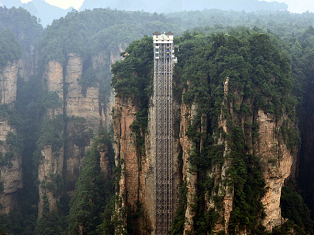
The tallest elevator in the world is located in the side of a cliff in China’s Wulingyuan scenic area. Constructed between 1999 and 2002, the Bailong Elevator’s shafts and tunnels were carved from a quartz sandstone column in the heritage-listed area, despite protests from environmentalists. Made of glass, it offers dizzying views to passengers, as it carries them 326 metres up the sandstone column to the top of a mountain range. 154 metres of the lift are embedded into the column, and the remaining 172 metres are set into exposed steel and other components. The journey takes just under two minutes, with lift cars running at three metres per second, taking up to 50 passengers at one time. Earthquake detectors are fitted into each car, to allow for a quick evacuation in case of an emergency.
Sources:
https://interestingengineering.com/5-of-the-worlds-greatest-feats-of-engineering
https://edition.cnn.com/travel/article/engineering-feats/index.html?gallery=10
http://www.topengineer.com/news-detail/the-world-s-top-10-most-amazing-engineering-feats//
https://10mosttoday.com/10-most-amazing-engineering-achievements/
https://www.iveyengineering.com/modern-engineering-marvels/
https://list25.com/25-most-monumental-feats-of-construction-in-history/
https://www.cntraveler.com/stories/2015-11-23/the-real-story-behind-dubai-palm-islands
https://www.theguardian.com/travel/2008/apr/26/travelnews
https://www.som.com/projects/burj_khalifa__structural_engineering
https://interestingengineering.com/kansai-airport-the-worlds-longest-airport
http://global.ctbuh.org/resources/papers/download/2624-structural-design-and-construction-of-the-foundation-of-tokyo-sky-tree.pdf
https://www.engineering.com/Library/ArticlesPage/tabid/85/ArticleID/79/The-Channel-Tunnel.aspx
https://www.telegraph.co.uk/travel/destinations/europe/france/articles/The-Channel-Tunnel-20-fascinating-facts/
https://www.eurotunnel.com/uk/build/
https://hardyservices.co.uk/blog/seven-wonders-civil-engineering-world-itaipu-dam/
http://www.armyengineer.com/history/panama/engineers/How_Canal_Works/How%20the%20Canal%20Works.html
https://www.motiondrivesandcontrols.co.uk/impressive-feats-engineering-3-panama-canal/
https://www.istructe.org/blog/2016/millau-viaduct-a-triumph-of-engineering
http://allthatsinteresting.com/millau-viaduct
http://www.grandcanyonskywalk.com/wp-content/uploads/2012/02/Skywalk-Facts-2012.pdf
http://abcnews.go.com/WNT/Travel/story?id=2957548&page=1
https://e360.yale.edu/features/rising-waters-can-a-massive-sea-barrier-save-venice-from-drowning
https://science.howstuffworks.com/engineering/civil/how-the-venice-tide-barrier-project-works.htm
https://www.mosevenezia.eu/mose/?lang=en
https://www.newcivilengineer.com/world-view/the-gallery-the-62m-giant-flood-gates-designed-to-save-venice/10028977.article
http://www.cannon-cannon.com/amazing-engineering/amazing-engineering-itaipu-dam/
https://www.nesgt.com/blog/2017/03/top-engineering-achievements-trans-siberian-railway
http://factsanddetails.com/russia/Education_Health_Transportation_Energy/sub9_6d/entry-5156.html
https://www.britannica.com/topic/Trans-Siberian-Railroad
https://interestingengineering.com/bailong-elevator-dare-ride-insanely-tall-outdoor-lift
Engineers wait with bated breath for a call they may never get. Earlier this year, the United Kingdom’s Foreign Secretary, Boris Johnson, proposed a 22-mile bridge to span the English Channel.
Eleven tunnel boring machines and engineering expertise created the 50.45 kilometer (31.35 mile) Channel Tunnel link between England and France.The tunnel took five years to build with a total of 13,000 workers from both England and France. If the building of a bridge is announced it would mean a sizeable payday for engineers attached to the project.
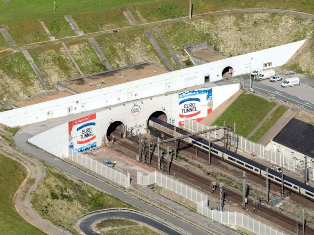
Some have dismissed Johnson’s intention to build the bridge - calling it a fantasy that will never come to fruition. However, Channel Tunnel operators Eurotunnel have expressed interest in the project.
Speaking in the House of Commons, Johnson said:
“It is a curiosity that two of the most powerful economies in the world, separated by barely 21 miles of water, are connected by only one railway line. And I think it is a matter for legitimate reflection by our two countries on the way forward.”
The bridge would be an impressive feat, not just considering the engineering prowess it would involve, but because it would be a post-Brexit achievement for the country which is due to leave the European Union, but still retain its business connections with France.
What they’ll need
If the plan to build the bridge goes forward, engineering professionals will either be tasked with creating a cable stayed bridge or a suspension bridge. There is just one glaring problem that is already causing speculators some consternation: boats.
Wanda Lewis, Emeritus Professor in Civil Engineering at the University of Warwick took to The Conversation, to explain. She writes:
“The channel is between 40m and 60m deep and some passenger ships are more than 70m tall. So to let ships pass underneath, the pylons supporting the bridge would have to be around 150m tall. To support the cables you would have to add pylons above the deck, which would mean a total pylon height well above 500m. Again, nothing this tall has ever been built.”
If the bridge does get built, it will be the world’s tallest bridge, and may just get recognition as a marvel of the modern world. However, with height comes wind and this strengthens with greater height. The bridge could be poised to deal with a number of wind-related engineering challenges.
With the longest bridge in the world as a case study, the Danyang-Kunshan Grand Bridge in China, the Daily Mail estimates that the bridge would cost approximately £824 million (USD 1.150 billion).
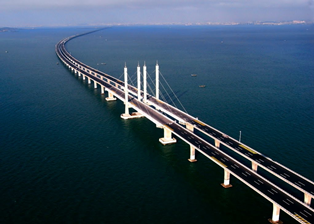
The Boris Bridge - as it has now been humorously dubbed - has received a great deal of backlash. The UK Government may indeed scrap the idea, but they are not ruling out the possibility of another tunnel.
Eurotunnel maintain that building a second link to England is not a matter of ‘if’ but a matter of ‘when’. Chief Executive of Eurotunnel Jacques Gounon wrote in a letter:
“The idea of a second fixed link is something that we regularly consider in our long term plans, and we would be delighted to engage with your officials to explore the possibility further.”
Works Cited
Lewis, Wanda. “Boris Johnson's English Channel Bridge: an Engineering Expert's View.” The Conversation, 12 Mar. 2018, theconversation.com/boris-johnsons-english-channel-bridge-an-engineering-experts-view-90409.
Ravenscroft, Tom. “Eurotunnel ‘Very Interested’ in Boris Bridge between England and France.” Dezeen, Dezeen, 14 Feb. 2018, www.dezeen.com/2018/02/14/eurotunnel-channel-tunnel-interested-boris-bridge-england-france/.
The speed at which a lithium-ion battery charges, remains a unique scientific and engineering challenge. Historically, slow charging has been responsible for limiting the development of vehicles and technologies that need to constantly recharge. This is, however, changing as technology advances.
The safety of lithium-ion batteries has also been a sore point in the history of battery technology. But with new sensor technology these batteries are becoming less risky.
Ensuring no thermal runaway occurs in Li-ion batteries is important for the future of vehicles and other technologies dependent on them. In fact temperature control, the speed of charging and general battery safety is paramount.
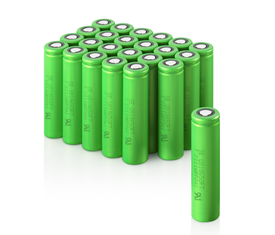
Interestingly University of Warwick researchers claim that Li-ion batteries already sold in commercial settings can be charged faster than previously thought. They also assert that this could improve their safety. With new sensor technology embedded into the battery a speedier charge and reduction in risk will result, they believe.
The researchers have published their findings in a journal named Electrochimica Acta under the title: “Understanding the limits of rapid charging using instrumented commercial 18650 high energy Li-ion cells.”
18650 high energy Li-ion cells are the ones found in our electronics, future electric vehicles and our energy storage units. Now, with new sensor technology, the inner-workings of the Li-ion battery can be monitored and will open a new pathway to battery flexibility.
Lead researcher Dr Tazdin Amietszajew says:
“This could bring huge benefits to areas such as motor racing, which would gain obvious benefits from being able to push the performance limits, but it also creates massive opportunities for consumers and energy storage providers.
The Warwick University researchers say the new sensor technology will allow for flexible charging functionality, but has revealed that we have been charging the batteries more slowly than necessary. Amietszajew said:
“Faster charging as always comes at the expense of overall battery life, but many consumers would welcome the ability to charge a vehicle battery quickly when short journey times are required and then to switch to standard charge periods at other times. This technology is ready to apply now to commercial batteries, but we would need to ensure that battery management systems on vehicles, and that the infrastructure being put in for electric vehicles, are able to accommodate variable charging rates that would include these new precisely tuned profiles/limits.”
It may even ensure that the Li-ion batteries do not overcharge. There are already measures in place to prevent electronics’ Li-ion batteries from overcharging, although it still occurs in certain Li-ion applications.
The Battery University explains:
“Prolonged charging above 4.30 volts on a Li-ion designed for a 4.20V/cell will plate metallic lithium on the anode. The cathode material becomes an oxidizing agent, loses stability and produces carbon dioxide (CO2). The cell pressure rises and if the charge is allowed to continue, the current interrupt device (CID) responsible for cell safety disconnects at 1000-1,380kPa (145-200psi). Should the pressure rise further, a safety membrane on some Li-ion bursts open at about 3,450kPa (500psi) and the cell might eventually vent with flame.”
The research into how to get Li-ion batteries performing more efficiently, being charged up more quickly and living longer, is important research. This glimpse into the future, thanks to Li-ion batteries, has already signaled a new ‘gold rush’ - with lithium being the gold. The future of clean, renewable energy applications may indeed depend on Li-ion batteries performing better than they already do.
Works Cited
“Charging Lithium-Ion Batteries.” Charging Lithium-Ion Batteries – Battery University, batteryuniversity.com/learn/article/charging_lithium_ion_batteries.
Posted March 11, 2018 by Travis Horesh & filed under Newswire, The Tech. “New Li-Ion Battery Sensor Tech Promises 5x Faster Charging.” Charged EVs, chargedevs.com/newswire/new-li-ion-battery-sensor-tech-promises-5x-faster-charging/.
The scientific world has lost one of its modern day pioneers. Stephen Hawking, a modern cosmologist, passed away at age 76, on the 14th of March 2018. Hawking’s most notable work, “A Brief History of Time”, sold over ten million copies and he is remembered for his work on general relativity and black hole theories.
His impact on engineering is not lost either; Hawking popularized communication devices that aid those who are unable to speak. Hawking developed Amyotrophic Lateral Sclerosis (ALS) at the age of 21 - a motor-neuron disease. After a bout of pneumonia, and due to the effects of ALS, doctors had to perform a tracheotomy on Hawking; he lost the ability to speak. The engineered technologies that gave him his voice back became wonders of biomedical engineering.
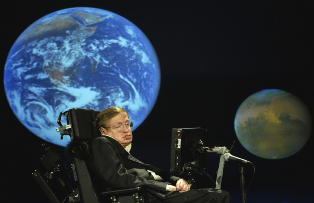
Hawking started out with a speech synthesizer called CallText 5010. It was run by an AMD processor.
He was eventually persuaded to utilize Intel’s technology after the CEO asked him if he wanted to use a ‘real computer’. Since then, Intel has mobilized the ‘Intel User Experience Engineers’ to regularly update Hawking’s communication system. It was Intel who provided Hawking with his distinct voice.
Engineer, David Mason helped fit Equalizer and Speech Plus software to Hawking’s wheelchair. The software was developed by a company known as Words Plus. The software needed a clicker pressed to articulate speech, but Hawking eventually lost the use of his hand. Thereafter an infrared sensor on his glasses was able to detect when he twitched his cheek muscle.
As Hawking’s condition deteriorated he found it increasingly difficult to type words efficiently; this limited his ability to communicate ideas and write books. In response Intel’s engineers tested a number of new methods, but seemed stumped.
Eventually predictive text entered our lexicon of terms and has become a feature on our smartphones. It involved a great deal of trial and error, but allowed Hawking’s communication to speed up. He used word predictors by popular keyboard app maker SwiftKey.
The technology was fleshed out and dubbed the Assistive Contextually Aware Toolkit. Hawking began to use shortcuts and menus that had some pre-predicted tools; it can cut down typing time by half.
Lama Nachman is an Intel Fellow and the Director of the Anticipatory Computing Lab at Intel Corporation. After his death she summed up the challenging biomedical engineering endeavors that were pioneered with and for him:
“Working with Stephen was the most meaningful and challenging endeavor of my life. It fed my soul and really hit home how technology can profoundly improve people’s lives. We will continue developing and refining this technology in the open source community in his honor, to reach all people in need. This is something he cared about deeply.”
Hawking had the option to change the sound emitted from his communication device, but he chose to keep his iconic, robotic voice. It became synonymous with the man; a man with an incredible brain, enormous courage and boundless determination.
Works Cited
Farrell, Nick. “Intel Remembers Giving Stephen Hawking His Voice.” Fudzilla, www.fudzilla.com/news/processors/45820-intel-remembers-giving-stephen-hawking-his-voice.
Cruise ship holidays are growing in popularity. What’s not to like? Breakfast buffets. All-you-can-eat pizza and burgers around the clock. Restaurant dinners. Drinks. Great sea views. As the appetite for cruise holidays intensifies, the cruise companies are lengthening their pre-existing liners.
Instead of building new ships they are slicing the existing ones in half and inserting new middle sections. This feat of engineering has become standard practice for profit-turning cruise ship companies. MSC Cruises lengthened four of their fleet back in 2014-2015 in one of the biggest operations of its kind.
And Silversea has just performed its first cruise ship stretching operation this year. The Silver Spirit has been split in half in readiness for a 15-metre addition. The operation will be completed by May 5th 2018 – taking a total of 450,000 hours to complete – and 12% growth. Once the ship has been completed it will embark on a 7-day journey between Rome and Barcelona.
New builds cost many hundreds of millions whereas MSC Cruises’ latest lengthening operation only cost the company US$227 million. It is far cheaper to lengthen ships than build new ones.
One of the challenges for engineers is to meticulously fit and maneuver the new section into the designated space; to ensure it aligns perfectly with the other halves. Once the new section is welded into place it is painted to blend in with the older sections. The Silver Spirit’s renovation includes a complete overhaul of the interior (the old furniture is being donated to charity). The new additions, in essence, become indistinguishable and the ships are sent back out to sea.
The companies rely on this added capacity to facilitate an increase in the number of passengers, and thus create more profit.
The lengthening of ships for profit is a modern exercise, but it is an old practice. In the past ships were lengthened to allow for more engine room; the first such operation occurred as early as 1871.
Works Cited
“Cruise Industry: Why Do Cruise Lines Cut Their Ships in Half? -.” - The First Online Cruise Magazine for the Middle East and South Africa., 29 Nov. 2017, cruisearabiaonline.com/2014/09/22/cruise-industry-why-do-cruise-lines-cut-their-ships-in-half/.
Mclaughlin, Kylie. “Silversea Cruise Ship Silver Spirit Cut in Half in Lengthening Project.” Stuff, www.stuff.co.nz/travel/cruising/102243159/silversea-cruise-ship-silver-spirit-cut-in-half-in-lengthening-project.
It is difficult to train for outdoor sports indoors. We can try to replicate naturally occurring factors such as hills, valleys, wind and rain; but nothing can adequately imitate what the outdoors is capable of producing (even when training outdoors). Cycling is no exception. Training is regularly conducted indoors, to control things such as resistance and drag when slopes are sparse. Or, when practise riding into a headwind is required and there’s not a breath of wind outside.
Previously, an ergo (stationary bike) was the option, where gears were simply changed to add resistance to the ride, slowing a cyclist down and causing him/her to push harder to achieve the same speed. A relatively new product has emerged, however; it is completely changing the training game.
AIRhub is a revolutionary cycling training device produced by Terrain Dynamics. It is an electromagnetic braking system which adds watts to your ride without adding mass. The AIRhub connects to your smartphone via Bluetooth, with the AIRhub app controlling your output in real time. “AIR” stands for automated integrated resistance, and hub of course being the 1.5kg physical attachment to the front wheel of the bike.
The aptly named Terrain Dynamics is the brainchild of Perth man Michael Freiberg, a gold and silver Commonwealth Games medallist himself and 2011 Omnium World Champion. Freiberg developed this remarkable feat of engineering after years of training for both track and road cycling. He was finding he couldn’t control and manipulate his training schedule exactly to his needs with the technology that was previously available; his routine was often dictated by his location or the weather on the day. As this inventor and managing director Freiberg says:
"With the AIRhub, we've created that. A smart, one-of-a-kind electromagnetic braking system that works with you and can be customised to suit your program and your terrain.”
AIRhub has a series of different modes to select from, each regulating the system in a different way.
- Manual mode: it can add up to 100 watts while riding. This mode is ideal when riding with slower cyclists; it allows for a slower speed, but with the use of more power.
- Heart rate mode: it monitors the heart rate and automatically adjusts resistance to keep the training in a specific zone. This mode is ideal if riding in a large group – it increases resistance when positioned in the middle/back of the pack and decreases it if at the front; it is designed to maintain a consistent heart rate.
- CDA mode: it increases coefficient of drag to simulate headwinds.

This product is versatile. It can be utilised by leisurely weekend riders - wanting to increase average speed by a couple of km/h, all the way up to elite athletes – wanting to hone in on specific heart rate targets, oxygen intake and output wattage. Sitting at a current price point of $1950 per unit, the AIRhub is a fairly significant financial investment, but one that when used correctly, can dramatically improve results in very broad or very specific areas.
“I hope everyone who's ever struggled to take their performance to the next level, whether it be because they live in a flat area, don't have safe roads to train on or have to train solo just to get in those hard sessions, can find their answer in the AIRhub.” M. Freiberg
The results speak for themselves, with riders demonstrating a 10-15% improvement in riding power with no additional effort.
References:
En.wikipedia.org. (2018). Michael Freiberg. [online] Available at: https://en.wikipedia.org/wiki/Michael_Freiberg [Accessed 12 Mar. 2018].
Rainmaker, D. (2017). Hands-on: The AIRhub on-road cycling resistance unit. [online] DC Rainmaker. Available at: https://www.dcrainmaker.com/2017/01/airhub-cycling-resistance.html [Accessed 12 Mar. 2018].
Terrain Dynamics. (2018). AIRhub. [online] Available at: http://terraindynamics.com.au/airhub [Accessed 10 Mar. 2018].
Electricity, seemingly abundant in our world today, is something that we take for granted. The reality, however, is very different in the world.
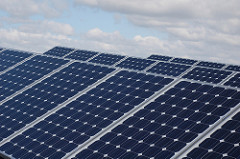
It is estimated that 1.3 billion people still do not have access to electricity.
Electricity can mean many things for communities. Once electricity is established within a community, the access to power can lead to better health care, education, and self-determination. And prosperity soon follows.
Powering rural areas is an engineering work in progress. The remoteness of some communities means that relying on the grid is impossible.
The technologies that have been used to bring power to remote villages have historically been those which impact negatively on the environment; diesel generators have been a common source of power.
Powering the remotest villages on earth
Ladakh is inside the Indian state of Jammu and Kashmir in the Kunlun mountain range within the Great Himalayas. A small number of inhabitants brave the cold in the area; Ladakh is 12,400 feet above sea level. Until a few years ago they had never used electricity.
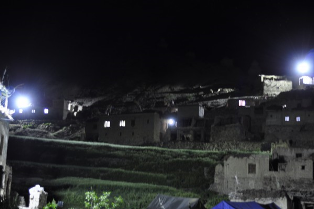
A team known as the Global Himalayan Expedition trekked to the remotest village in Ladakh: the village of Shadé.
These wonderful and courageous volunteer engineers installed a Solar Nano-Grid to provide the inhabitants with electricity in 2017. This complimented one previously placed in the village. The first installation had never been robust enough to power the entire village.
It took the team four days to travel the 56 miles before reaching Shadé Village. The Kashmir Monitor wrote:
“The village has never received any grid based electricity. The villagers have been using Solar Home Lighting Systems and old kerosene oil lamps. In winters, the village remains cut-off from the outside world for about six to seven months. There is one satellite phone in the village, which was installed in 2013 and remains the only medium of communication between the village and the outside world.”
The team intends to provide nanogrids to surrounding villages as well. They have been working to electrify a dozen other villages in the Himalayas in an expedition that started in 2013. The citizens of the villages are understandably delighted.
The government has, however, signed a Memorandum of Understanding with the Centre of Development in India to get two mega solar parks built in the region of Ladakh. This will be enormously valuable to the inhabitants in the region; securing them with a sustainable supply of electricity.
To see more of the work being done in the Himalayas, here is a documentary on the projects from NDTV:
Works Cited
“Remotest Village in Ladakh Gets Electricity for the First Time.” Kashmir Monitor, 14 May 2015, kashmirmonitor.in/Details/129269/remotest-village-in-ladakh-gets-electricity-for-the-first-time.
If you don’t have steel you don’t have a country - so says the President of the United States Donald Trump. And, based on an investigation conducted by the American government, their country had drawn the short straw when it came to steel imports and exports. To ensure it did not impact the elusive ‘American Dream’l import tariffs were back on the table.
President Donald Trump has announced a 25 percent tariff on steel articles exported to the United States. In an official proclamation, he said:

“This relief will help our domestic steel industry to revive idled facilities, open closed mills, preserve necessary skills by hiring new steel workers, and maintain or increase production, which will reduce our Nation’s need to rely on foreign producers for steel and ensure that domestic producers can continue to supply all the steel necessary for critical industries and national defense.”
And yet American steelworkers have been wondering where they fit in into the future of the metalworking industries - the increasing automation of steel factories will inevitably hollow out traditional roles. Barack Obama, before the end of his presidency, was quizzed on the return of jobs to the steel sector. He was less optimistic than his successor.
President Donald Trump is making a concerted effort to refocus attention on metalworking factories; the new tariffs will add 25% to steel imports and 10% to aluminum. Tariffs on foreign washing machines and solar panels were also recently imposed by his government.
Trump, on March 7th, tweeted:
“From Bush 1 to present, our Country has lost more than 55,000 factories, 6,000, manufacturing jobs and accumulated Trade Deficits of more than 12 Trillion Dollars. Last year we had a Trade Deficit of almost 800 Billion Dollars. Bad Policies & Leadership. Must WIN again! #MAGA”
Car manufacturing and beyond
Whilst most people would decry the tweets as Trump’s notorious ‘alternative facts’, a CEO of multiple engineering companies on the cutting edge of modern day engineering agrees that American business has not been getting a fair deal.
CEO of Tesla Motors, Elon Musk, also took a seemingly pro-tariffs stance. Responding to Trump on Twitter, Musk tweeted:
“Do you think the US & China should have equal & fair rules for cars? Meaning, same import duties, ownership constraints & other factors. For example, an American car going to China pays 25% import duty, but a Chinese car coming to the US only pays 2.5%, a tenfold difference. We raised this with the prior administration and nothing happened. Just want a fair outcome, ideally where tariffs/rules are equally moderate. Nothing more. Hope this does not seem unreasonable.”
Trump read Musk’s tweets from a printed piece of paper as he announced the Presidential Proclamation on Adjusting Imports of Steel into the United States.
Chief Equity Strategist for Goldman Sachs David Kostin said
“Steel is the primary material used by Automobile manufacturers Ford and General Motors. Based on 2017 production mix, if the proposed tariff of 25% on imported steel translates into a similar magnitude of increase in steel prices, it would impact each firm by roughly US$1 billion, representing 12% and 7% of their 2017 adjusted operating income, respectively.”
Furthermore, there are of course fears that the suggested tariffs could start a trade war with other superpowers, something China has all but confirmed. BHP Billiton CEO Andrew Mackenzie too is disheartened by the talk of tariffs. At a business summit on Tuesday, the 6th of March 2018, the CEO hit out against Trump’s attacks on free trade, calling the announcements a ‘black day for the world’. He said:
“I am worried about this sentiment shift that people all around the world might suddenly say that free trade isn’t good for the world and that would be particularly bad for a trading company like BHP. We have to speak up loudly against these measures as being bad for America and bad for the world.”
Works Cited
Cheng, Evelyn. “Goldman: GM and Ford Could Take $1 Billion Hit Each from the Steel Tariffs.” CNBC, CNBC, 5 Mar. 2018, www.cnbc.com/2018/03/05/goldman-tariffs-to-knock-gm-terex.html.
Williams, Perry. “Trump Tariffs Are a Black Day for the World, Says BHP CEO.” Bloomberg.com, Bloomberg, 5 Mar. 2018, www.bloomberg.com/news/articles/2018-03-06/trump-tariffs-are-black-day-for-world-business-bhp-ceo-says.
The 3D printing industry is a special one. A 3D printer has several necessary components: heat beds, bed surfaces, the printing materials (resins or filaments), extruders, hobbed gear, and more. Depending on the kind of printing materials engineers use, different printers are necessary. These several technological parts that make up a 3D printer can be sourced from around the globe from several manufacturers.
Thus, it takes quite a lot of engineered parts to make up an SLA workshop. What is a SLA workshop, you might ask?
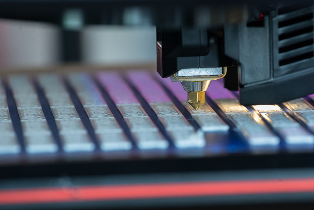
It is a 3D printing facility that utilizes the printing method known as stereolithography (SLA) - less commonly known as additive manufacturing. Companies are building 3D printing factories, turning the advent of newer, improved 3D printing into businesses.
A SLA workshop utilizes the kinds of 3D printers that convert liquid materials into solid parts by printing them layer by layer using lasers or light sources. Using light sources to turn liquid materials into solids is done through a process known as photopolymerization.
It is known to be the most accurate method of 3D printing.
YouTube channel ‘Strange Parts’ went to investigate how Chinese 3D printing company Lexcent prints its parts.
Lexcent uses resins provided by a company in Europe named DSM Resins & Functional Materials. They are the leading global supplier of high-quality resins for 3D printing and other liquid material based applications. The lasers at Lexcent are manufactured in Germany.
The company offers a printing service. All you do is place an order, and their facility works around the clock to print a design that is sent to them for a nominal price.
It is important for companies doing high-profile additive manufacturing to have high-quality resins and precise printers. If any cutting of corners occurs in the additive manufacturing industry, printed solids can come out with rough exteriors or have uneven edges.
Thus, Lexcent has to regulate temperatures within its facility to ensure the printers do not overheat - if the resins are exposed to temperatures of 104 Fahrenheit or over, the items will not print properly. The company also has to utilize different colored lighting so that no white light interferes with the SLA printing method which utilizes its own laser-focused light.
Nonetheless, once a print has been completed, parts are sent into a workshop for polishing. This ensures that any rough edges are eliminated. Then, the parts are shipped off to the paying customers.
Each SLA 3D printer at Lexcent’s headquarters costs around US$55,200 - the company has eight of them. They also have 13 CNC machines for heavier duty additive manufacturing; they make titanium alloys, aluminium alloys and harder plastics.
Fused Deposition Modeling
Another company making their bread and butter off 3D printing is Voodoo Manufacturing. They have introduced something called the ‘Large Format 3D Printing’ service. Customers who require large scale, industrial-sized prints can send it to Voodoo Manufacturing - their printer, considered the biggest in the world, prints a customer’s file. They have added 10 Raise3D N2 Plus Printers which uses a form of printing called Fused Deposition Modeling.
The Fused Deposition Modeling 3D printing method uses fused filament fabrication. Instead of solidifying liquids, a continuous filament is melted and pushed out of a nozzle. The filament eventually becomes the solid it was instructed to print.
In many universities there are now 3D printing facilities which allow students to become familiar with these printing technologies, they often print t their own CAD files. And the emergence of 3D printing businesses allow customers to have rapid prototyping and additive manufacturing work done at reasonable prices.
Works Cited
“Voodoo Manufacturing Introduces Large Format 3D Printing Service.” Advanced Manufacturing, 21 Feb. 2018, advancedmanufacturing.org/voodoo-manufacturing-introduces-large-format-3d-printing-service/.
There is a toy revolution occurring. A renewed, concerted effort is underway to make toys for children and young adults, to condition their minds in preparation for the world of STEM (Science, Technology, Engineering and Mathematics).
Schools are implementing STEM programs which involve classroom renovations that are stimulating, but fun. For some time now too many students have been losing interest in science and maths, even before they reach high school, making it very difficult for them to rediscover a love for these later on. This not only limits their employment prospects, but leaves them without the excitement that STEM disciplines promise throughout their lives.
Primary schools are making a concerted effort to mitigate this slide. Robotics and innovative problem solving technologies, designed to cognitively challenge students, are creeping into classrooms. To ensure that this occurs around the world (even in the most rural areas), the technologies and learning equipment employed need to be as affordable as possible.
Nintendo has been showcasing what the future of STEM-inspired fun can encompass. Their new innovation utilizes one of the most cost-effective, most abundant materials known to man: cardboard.
Nintendo’s latest console, the Nintendo Switch, is a favorite amongst youths who are pressuring their parents to buy it. And it just got cooler. Nintendo has launched ‘Labo’; - it includes foldable cardboard sheets that interconnect with the gaming console.
The user folds the cardboard (DIY fashion) and connects it to the console controllers so that it can be used to play the games on the 6.2 inch screen.
Nintendo’s console has motion-sensing technology built in, making the cardboard interfacing even more fun. For instance users can fold together (in an almost origami fashion) a cardboard steering column and play a racing game on it.
The company has also introduced a robot suit, RC car, piano and fishing rod – all made out of cardboard and rubber bands.
Nintendo is hoping its new cardboard range will become tools that will spur kids to pursue STEM subjects later on in their academic lives.
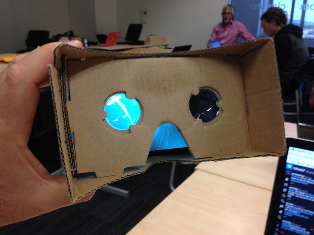
Cardboard simulation technologies seem to be a marker for where the education and training industry is heading. Just a few years ago, companies were releasing cardboard virtual reality goggles with cheap lenses. It was a glimpse into the future of virtual reality. Since then, virtual and augmented reality headsets have taken off in a big way.
The only problem with Nintendo’s Labo? The price. Their Variety Kit costs US$69.99, and the Robot Kit costs US$79.99. Some parents will find this prohibitive. Nonetheless, if foldable cardboard toys that interface with technology become a focus for stimulating children in the fields of STEM, lower prices for similar technologies must follow.
Works Cited
Horaczek, Stan. “Nintendo's Labo Cardboard STEM Toys Are a Recycling Bin Full of Fun.” Popular Science, 2 Feb. 2018, www.popsci.com/nintendo-labo-stem-toy-impressions#page-3.
Are you interested in expanding your professional network globally and speaking to outstanding engineering students and graduates about your incredible engineering career?
By joining our Distinguished Industry Guest Speaker Program you will have the unique opportunity to share your technical insights and engineering experiences with our engineering bachelor and master students located at our East Perth campus. Your presentation can also be streamed to EIT’s 500,000+ followers around the world. It is an opportunity to raise your professional profile and keep your finger on the industry pulse nationally and internationally.
We are determined to expose our wonderful engineering students to engineering professionals such as yourselves so that they get a practical and useful engineering education.
Interacting with our enthusiastic students will give you and your company the chance to connect with the next generation of engineers and technicians and learn more about their practical projects and possible areas of collaboration.
An honorarium will be paid for your valuable contribution and you can also gain full access to our digital library of technical resources. We are particularly interested in professionals with industry experience in any of the following engineering areas: Industrial Automation, Electrical, Mechanical, Civil and Structural. To find out more, please contact Carolina Asenjo (
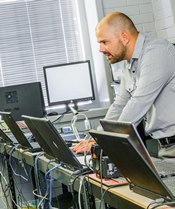 I have seen it; the future of engineering education and training. I have seen how it will equip engineering professionals globally and enable them to continue contributing to the turning of our world.
I have seen it; the future of engineering education and training. I have seen how it will equip engineering professionals globally and enable them to continue contributing to the turning of our world.
Acquiring professional development in engineering is changing; this process can be tracked by looking at the adaptations and growth of the Engineering Institute of Technology (EIT).
Over 25 years ago EIT was providing short classroom courses and onsite workshops. With the emergence of the internet the college began to keep an eager eye on the opportunities this would present to the world of engineering education.
Half a million students have since flown through our programs.
About ten years ago a live, online learning platform was devised for a range of accredited vocational qualifications. This enabling technology was one thing, but was never going to supersede a great teacher: the expertise of engineering professionals from around the world, with real industry experience, was the key. Their years in the trenches have been used for content development and for teaching. They also contribute to the creation of remote laboratories and simulation software.
The Internet-of-Things (IoT) has meant that our students can ably complete their practical learning via these remote labs; the reality is that most engineering tools are linked to the internet. I oversee the setting up of our virtual labs; they are connected to real engineering machinery that our students log into from across the globe.
Three years ago the college’s scope broadened with the accreditation of a range of Bachelor and Master Degrees, also delivered online. The reach of this learning platform has meant that EIT’s alumni hail from 146 countries.
One of the overarching benefits of connecting with students remotely, of removing a campus from the mix, is that they can attain their professional development and accumulated qualifications alongside full-time work.
I recently attended a schools’ career expo in South Africa and witnessed the hunger and passion of young students wanting to pursue engineering as a career. Despite the connectivity of young people we realised that school leavers do indeed benefit from face-to-face education, from engaging with their peers and lecturers on campus.
The institution’s latest achievement is the opening of a higher education campus in Perth, Western Australian. The traditional classroom has been blended with the ever-improving technologies surrounding online learning. This ensures that our international, engineering experts are still streaming into the classroom for the on-campus students.
It is an incredible privilege to be the Deputy Dean of Engineering at the college and I am certain that EIT will continue to explore innovative and meaningful education for engineers today and into the future.
A Moodle Upgrade is Inbound...

The Engineering Institute of Technology has been in the works of implementing a new and improved Moodle LMS.
Here at EIT, we work diligently to ensure that we comply with the latest web standards available on the market. We’re dedicated to providing anonymity for all our students’ data, and ensuring that everyone has a comfortable experience when interacting with Moodle.
We are in the works of upgrading our current LMS, which will yield numerous benefits for all our students once implemented.
How Does this Impact Me?
As we endeavour to perform the upgrade, we’ll be forced to take Moodle offline for the weekend. This is a requirement of the upgrade, as the server will be under significant stress throughout this time. It also ensures that we mitigate any potential data corruption that could occur.
We highly recommend students download all the relevant materials they intended to use throughout the course of the weekend, as they won’t be accessible from Friday the 2nd of March at lunch time.
When we have completed the upgrade, we will then send an email out informing them of the status. We then urge all students to check that everything is in working order, as that will assist staff with cracking down on any potential errors or gaps.
2018 March Timeline:
- 2nd Friday: Moodle will go down at lunch time.
- 3rd Saturday - 4th Sunday: Upgrade in progress.
- 5th Monday Moodle will be live and useable again.
We’re undertaking this upgrade to enhance the experience of our students; therefore we thoroughly appreciate everyone's patience with this endeavour.
What is the Purpose of the Upgrade?
Theme
We have implemented an overhaul of the current platform, ensuring that our Moodle complies with the modern UI standards. The aesthetics of the platform attempt to focus the content relevant to you, highlighting any important updates or links that are presented by the LSO’s.
Functionally, the new look endeavours to reduce overall load speeds, and reacts well when accessing the platform on a mobile device.
Don’t panic though, as the primary navigation around the site platform has not changed all that much.
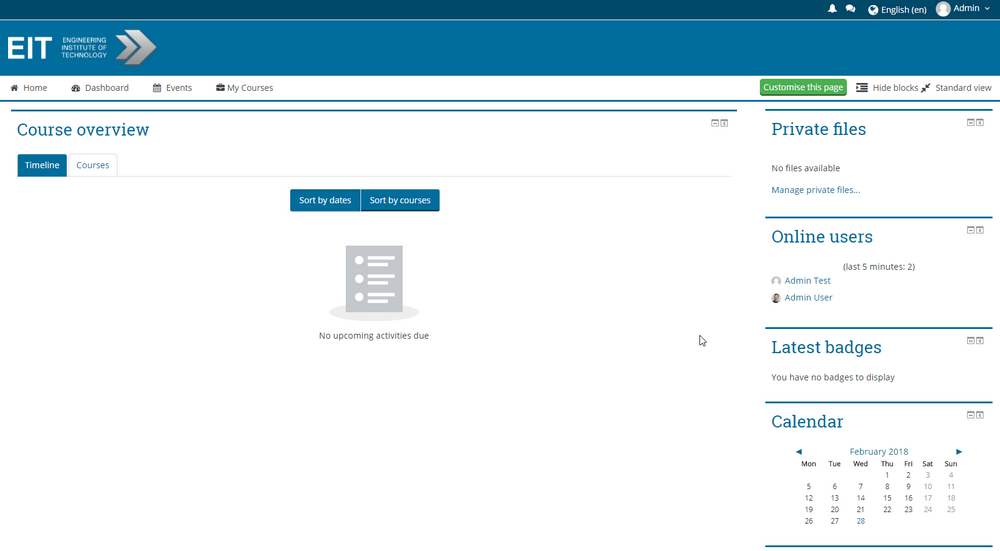
Security

We’ve noticed some minor security issues starting to appear on the platform; which has prompted us to move forward with the system. The new Moodle upgrade will facilitate the most up to date security features, ensuring that the data and course work of our students is protected.
Security of our students is our top priority at EIT. We will stop at nothing to ensure total anonymity of sensitive data, and protection against malicious attacks external to the platform.
The United Kingdom is between a rock and a hard place in the lead up to exiting the European Union. One of the concerns is that with a hard Brexit, EU students may not form part of the makeup of engineering professionals in the country’s future. Thus, more British-born students are being encouraged to pursue STEM (Science, Technology, Engineering, Mathematics) qualifications.
The Prime Minister of the UK, Theresa May, has used reverse-psychology to encourage more students to invest in STEM qualifications rather than in the humanities. The plan includes making arts studies cheaper than more STEM-focused qualifications. Essentially, she wants to devalue the arts.

The government will suggest that majoring in the arts may lead to ‘lower earning potential’ for students, whereas STEM degrees offer higher monthly salaried jobs. These suggested revisions are part of May’s current university ‘overhaul’ plan - a plan she is hoping may provide England’s students with improved education.
Nicky Morgan, a former education secretary, talking to the Evening Standard doesn’t believe devaluing BA degrees is a good one. She said:
“We want everybody to feel that all careers are open to them. If those who are struggling to afford university in the first place feel they cannot do a STEM degree because it is too expensive, ultimately it is the country that will suffer.”
Alongside this students in the United Kingdom are demanding that the government provides free education - a call that has been echoing in many universities around the world. Fees for courses in the UK can reach a maximum of £9,250 per year (US$ 12,866), with interest rates of 6.1% on any student loans. UK universities are among the most expensive in the world, next to the United States.
Putting arts into engineering
Qualification costs aside – there is an interesting push to embed the arts into engineering education. Among other benefits, such as improved communication skills, there is the belief that the arts may well enhance engineering designs.
Océane Boulais was the Hispanic Professional Engineering’s Extreme Engineer of the Year in 2014. Giving a TEDx Talk in 2015, she used Leonardo Da Vinci, Albert Einstein and Steve Jobs as examples of minds who expertly crafted artistic elements into engineering and scientific elements.
She is an advocate of putting the A in STEM: Science, Technology, Engineering, Arts, Mathematics.
She too highlights the fact that liberal arts qualifications get little funding compared to STEM qualifications. Yet, if STEAM-focused creators such as Da Vinci, Einstein, and Jobs created some of the most renowned products, then liberal arts should be more respected in STEM qualifications, Boulais argues.
Works Cited
“Integrating Art with STEM Education | Océane Boulais | TEDxBocaRaton.” YouTube, 5 May 2015, youtu.be/DjpWQkmopgY.
“Theresa May Warned Cheap Fees for Arts Courses 'Risk Driving Poor Students Away from Science and Tech'.” Evening Standard, 19 Feb. 2018, www.standard.co.uk/news/politics/theresa-may-warned-cheap-fees-for-arts-courses-risk-driving-poor-students-away-from-science-and-tech-a3770291.html.
One of the islands in the Japanese archipelago is Hokkaido. Sapporo, a city on the island, is burdened by snow; it costs 20.4 billion yen (US$190 million) on snow removal every winter.
Local government removes snow on state owned properties and streets, but private property owners are on their own. Alarmingly, it is not uncommon for a meter of snow to fall overnight in Sapporo.
From time to time the air force is required to perform rescue operations on houses that have been snowed in to the point of catastrophe. After all 1 cubic meter of snow weighs 500kg. This weight has resulted in many roof collapses in the suburbs of Sapporo.
A collection of technologies is both publicly and privately utilized to eradicate snow from the houses and streets of Sapporo and in Japan as a whole. Airport runways have to be cleared of snow and airplanes sprayed with anti-ice chemicals, for example. Impressively, Japan never cancels flights due to the cold.
Historically, Japanese cities have used warm groundwater and sprinkler systems to spray the roads and dissolve the ice. And back on the streets of Sapporo, snow plow trains are used to clear them of snow.
3,355 miles (5,400 km) of snow is cleared from Sapporo overnight. The work is done from midnight onward so that traffic is not impacted during the morning rush hours. Snow gutters have been added to the infrastructure of Japanese towns and cities, including Sapporo. These gutters dump snow into rivers.
The city has 47 weather stations that monitor temperatures and generate data on weather conditions. These help prepare the government snow removal teams. Data is checked hourly to get a real-time picture of weather patterns - sometimes lives depend on it.
After a heavy snowfall rotary snow removers flatten and transfer snow into dump trucks. Snow removal trucks are used to dump 20 million cubic meters of snow; this creates 10 to 20 meter high mountains at snow dump sites every winter.
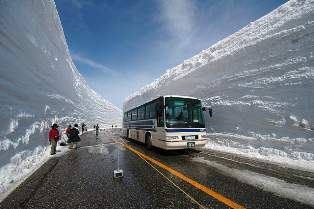
For the safety of human beings, faced with iced up roads, there are gravel stations in Sapporo. 1,200 boxes filled with gravel bags are peppered across the city. The gravel is used to spread across the icy ground; it makes walking in the city less hazardous.
Further afield, near the city of Toyoma is Mount Tateyama, one of Japan’s holy mountains. The road leading up to the mountain is known as Snow Canyon. Extensive snow plowing is required to keep it clear for traffic; it creates mighty snow walls as seen in the picture.
The Japanese Society of Mechanical Engineers has indicated that an automated snow clearing robot is to be developed; it would work constantly to clean construction areas. This is technology that may indeed be used more widely eventually. Presently 3,000 people are employed though the night in Sapporo, to eradicate snow from the city. An automated roof snow-clearing robot has also been proposed, to assist the elderly who sometimes injure themselves trying to remove snow from their roofs.
Clearing snow in Japan is one of the most interesting engineering challenges in the world, and every year the Japanese improve the way they tackle it.
Works Cited
“Japanology.” YouTube, YouTube, www.youtube.com/channel/UCd4V3I7nYybm4nKwONcOSdA/videos.
Nobel, Justin. “How to Clear a Path Through 60 Feet of Snow, Japanese Style.” Atlas Obscura, Atlas Obscura, 10 Mar. 2017, www.atlasobscura.com/articles/snow-canyon-japan.
Victorien Erussard, an offshore racer and Merchant Navy officer has taken to the seas aboard the latest marvel of engineering. He has set aside six years of his life to travel around the world in a boat that will not generate any carbon.
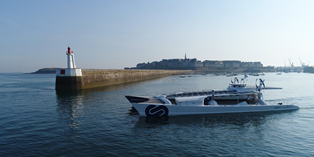
50 engineers, designers and naval architects worked on the interdisciplinary, multifaceted ‘Energy Observer’ boat. The racing boat is powered by an assortment of renewable sources such as: a hydrogen fuel cell system, solar panels, and wind turbines.
The boat will visit 50 countries. 101 stopovers will be observed during the trip. It will be the first ‘hydrogen ship around the world’ the engineers behind the boat professed. At every stop, the team will investigate renewable energy projects and meet with leaders. So far they have met with Prince Albert of Monaco and the President of France Emmanuel Macron.
Documentary-maker Jerome Delafosse, is following the Energy Observer in its six year journey and keeping audiences entertained by releasing constant YouTube updates of its progress. In the intro video to their expedition, he said:
“The only way to combat global warming is to reduce greenhouse gas emissions. Today, we know that renewable energies and hydrogen is THE path forward. Energy Observer has taken up the challenge of becoming the symbol of energy transition to prove that a cleaner world is possible.”
The boat is 100 feet long and quite aesthetically pleasing. It is also a symbol of engineering change - a signal to other marine engineers that the times are a-changin’. The boat represents a hope that one day marine vessels may be powered only by renewable sources. The boat cost $5.25 million - and it’s easy to see why; there are 1,400 square feet of solar panels fitted on the surface of the boat.
Launched from Paris in May 2017, the boat is nearing its first full year at sea. The technology on board propelling the boat forward was developed by French research center CEA-LITEN. When the sun is shining and the wind is blowing it uses the solar panels and wind turbines. When the moon is in the night sky, it utilizes its hydrogen tanks to propel it.
The hydrogen fuel it uses is “three times” more efficient than regular fuel. The fuel is created through sea water electrolysis. Delafosse believes the technology powering the boat can be used in many more applications. He said:
“We can use this technology in hotels, houses, in cars...the idea is to be less dependent on the network. It shows how fast things can happen: as it did in London at the turn of the last century when moving from horses to cars, it will happen with renewable energy.”
Works Cited
Energy Observer, www.energy-observer.org/en/.
Dockrill, Peter. “This Self-Fuelling Boat Just Set Off on an Epic 6-Year Global Voyage.” ScienceAlert, www.sciencealert.com/this-self-fuelling-boat-just-embarked-on-an-epic-6-year-global-voyage.
More engineering industry jobs are coming to South Africa. That is, if the country’s brand new president, Cyril Ramaphosa, is to be believed. Much like in the United States, the new sitting president is promising the renewed strengthening of manufacturing and mining jobs - whilst promising that the Fourth Industrial Revolution will be a focus as well.
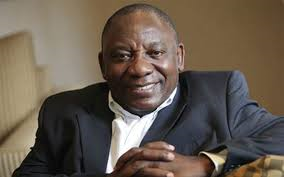
President Cyril Ramaphosa has given his State of the Nation Address a day after being sworn in as president. This, after the country’s previous president, Jacob Zuma, resigned from his position. Zuma’s presidency had produced a legacy of corruption that had sent the country’s economy into freefall.
Ramaphosa was the founder of the Union of Mineworkers in South Africa. He is also a successful businessman, and was a key negotiator for the African National Congress, credited for being one of those who helped facilitate the end of Apartheid. He was Nelson Mandela’s choice for the future president of South Africa.
Now his time has come. Plaguing the country is a high unemployment rate. Nonetheless, Ramaphosa is promising a revival of South Africa. He has said a new dawn is here for the country. In his State of the Nation address, he spoke of the mechanisms that might make South Africa great again:
“We are going to address the decline over many years of our manufacturing capacity, which has deeply affected employment and exports. We will seek to re-industrialise on a scale and at a pace that draws millions of job seekers into the economy. We are going to promote greater investment in key manufacturing sectors through the strategic use of incentives and other measures.”
Mining is one of the largest and more archaic industries in South Africa. A gold rush in the late 1800s began turning South Africa into a resources haven. The rest is, as they say, history. However, mining has struggled in the last few years. Ramaphosa said:
“Mining is another area that has massive unrealised potential for growth and job creation. We need to see mining as a sunrise industry.”
With a soon-to-be revitalized economy, the best thing school leavers and wannabe students can do is find education and training that will prepare them for this new South Africa.
The level of technological expansion in the country may, however, impede growth in the economy and education. South African institutions are struggling to produce highly qualified, globally relevant engineering professionals, for example. Ramaphosa is proposing change here too. He said:
“We will soon establish a Digital Industrial Revolution Commission, which will include the private sector and civil society, to ensure that our country is in a position to seize the opportunities and manage the challenges of rapid advances in information and communication technology. The drive towards the digital industrial revolution will be underpinned by the availability of efficient networks.”
Works Cited
Eyewitness News. “[MUST READ] President Ramaphosa's State of the Nation Address.” Eyewitness News, 17 Feb. 2018, ewn.co.za/2018/02/16/must-read-president-ramaphosa-s-state-of-the-nation-address.
Students and professors in research and development teams in the United States are setting the standard for nature-inspired engineering designs. Using nature as an influence for design, and using engineering design to better understand nature, may produce fruitful outcomes for engineering and nature alike.
A mechanical engineering team at the University of Illinois is using butterflies and snake scales as a blueprint for creating a new surface that will be used for ‘fluid and light manipulation’.

The team says the surface could service the scientific and engineering communities. In their paper, entitled ‘Magnetically Responsive Elastomer-Silicon Hybrid Surfaces for Fluid Light Manipulation’, they write:
“Stimuli-responsive surfaces with tunable fluidic and optical properties utilizing switchable surface topography are of significant interest for both scientific and engineering research.”
The engineers say that with their surface as a base, materials can be laid atop it. They are nanostructures that copy, to some extent, the subtlety of butterfly and snake scales. The engineers designed what are called ‘ferromagnetic micropillars’ above a flexible bottom later.
Thereby, the surface can be used for a plethora of applications including: ‘tunable wetting, droplet manipulation, tunable optical transmissions, and structural correlation’.
It all sounds very complex, but with tunable optical transmissions, virtual blinds could be designed, for example. Imagine booking into a hotel room and darkening the room without physically having to pull down the blinds. The window itself would be fitted with the light manipulating technology utilizing the scale-like nanostructured surface.
Other applications include biomedical engineering applications, implantation into photovoltaic arrays and more. Seok Kim, the assistant professor of mechanical engineering, said that he wanted to ‘emulate’ designs found in nature.
Helping nature out
At the University of Colorado Boulder an aerospace engineering team has put their energy into figuring out how to study animals more closely. Their senior design project saw them designing technology for the preservation of nature.
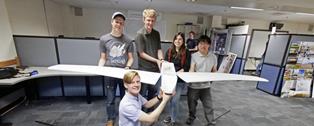
They have designed a drone that can get the closest to sperm whales than any other apparatus before.
Previously, marine biologists have reportedly been limited to binoculars and hydrophones. What the biologists want to do is voyeuristically listen in on sperm whale communications to decipher the ‘language’ sperm whales are using. The project’s name is - whimsically - SHAMU (Search and Help Aquatic Mammals UAS), which was also the name of a killer whale that was held at SeaWorld in San Diego in the United States.
The team is hoping the unmanned aerial vehicle will contribute to lessening the number of sperm whale deaths per year. The university’s online publication asserts that pollution and ‘collisions with ships’ lead to 1,000 sperm whale deaths annually. With more data generated, the engineers are hoping it could give marine biologists something to work with.
Lauren McIntire, the head of safety on the project said:
“One of the main reasons most of us joined the project is the desire to use engineering to better the world. In aerospace there’s a focus on defense or commercial projects, but SHAMU is about conversation and helping all life on earth.”
Works Cited
“Pushing Boundaries: To Save the Whales, Engineering Students Take to the Skies.” CU Boulder Today, 14 Feb. 2018, www.colorado.edu/today/2018/02/14/pushing-boundaries-save-whales-engineering-students-take-skies.
Yang, Zining, et al. “Magnetically Responsive Elastomer–Silicon Hybrid Surfaces for Fluid and Light Manipulation.” Small, 24 Nov. 2017, onlinelibrary.wiley.com/doi/10.1002/smll.201702839/full.
“Help me Obi Wan Kenobi, you’re my only hope”. - Princess Leia
In 1977, science fiction fans were treated to the very first Star Wars film. Years later, the series has branched off into comics, novels, more films, animation shows, and more. But back in ‘77 when Princess Leia spoke her very first words in the series, R2-D2, the robot relaying Leia’s three-dimensional recorded message, showed the world what the future of holograms could be.

A team of engineers at Brigham Young University, in Utah in the United States, have been working to make science fiction, science fact. Using the scene from Star Wars as an influence, the team started their ‘Princess Leia project’.
Using a phenomenon known as photopheresis, the engineers have manipulated unseen airborne particles with lasers to produce images in midair. The team has said the 3-D images are even more realistic than holograms.
They released a video to demonstrate their findings, and to give a sneak peak into the future of volumetric displays:
Historically holograms have been produced by using rotating or specially positioned glass displays with images projected onto them. Other methods have included using fog, mist, or dust on which to project 2D images - Disney has used these kinds of projection methods at their theme parks. But the Birgham University scholars have figured out a way to project 3D images onto thin air, making it significantly different to previous holography attempts.
Daniel Smalley, lead author of the photopheresis research, and an electrical and computer engineering professor, said that the new technique is tantamount to “printing something in space,” and then, “erasing it quickly.” The unseen specks are focused together by laser technology guided by mirrors.
The authors are ditching the ‘hologram’ name, due to its departure from holographic ideology and instead calling their invention the Optical Trap Display. They essentially trap particles and create a volumetric image in three-dimensional space.
100 years of research into these methods have been categorized as ‘volumetric display’ research. They have published their research in the Nature journal. The researchers fully intend getting this technology to market. In the report, they write:
“The reported prototypes use commercial hardware and have low cost relative to other free-space volumetric displays. We anticipate that the device can readily be scaled using parallelism and consider this platform to be a viable method for creating 3D images that share the same space as the user, as physical objects would.”
This means that the world is also closer to telepresence: much like the scene from Star Wars with Princess Leia, and a plethora of other science fiction novels and movies. We could soon see engineers perfect a ‘holographic’ Skype call – a bit like being in two places at one time. A Star Wars future might, therefore, not be far off.
Works Cited
Matt WarrenJan. 24, 2018 , 1:00 PM, et al. “'Princess Leia' Holograms One Step Closer to Reality.” Science | AAAS, 24 Jan. 2018, www.sciencemag.org/news/2018/01/princess-leia-holograms-one-step-closer-reality.
Smalley, D. E., et al. “A Photophoretic-Trap Volumetric Display.” Nature News, Nature Publishing Group, 24 Jan. 2018, www.nature.com/articles/nature25176.
The world is still looking for the most effective way of educating and training people. Privately owned universities and institutions are keeping their eyes on initiatives in the business sector.

Universities are looking towards the most efficiently built organizations of the last decade, noticing how they have construed to scale up. With the arrival of the internet and lower cost technologies, institutions have had to formulate new strategies. They have created online platforms for their students, saved money by reducing their dependency on infrastructure and extended their reach to students who are based around the world.
Tim Dodd, the Higher Education Editor for the Australian newspaper, says universities are following the Uber-model when it comes to transformation. He writes:
“Does this business model remind you of anything? To me it smacks of Uber or Airbnb, companies with no physical assets but enticing enough to consumers to dominate their sectors. So here’s the question. Are we entering the age of the Uber-university?”
Even investment companies are conceding that Uber, as a case study, has made them rethink how they provide their services to customers. Uber’s business model has led them to be the most profitable taxi service in the world. (They originally did not own the cars, but now have engineers designing automated vehicles that are self-driving.)
Many universities and institutions are hoping to follow suit; they are realigning their businesses to resemble a zero-cost operation like Uber without the cost of cars.
Business...what is it good for?
Companies are growing in strength and offering services that their founders probably never dreamed they would be offering when they founded their companies. Amazon, for example, is teaming up with Warren Buffett's Berkshire Hathaway and JP Morgan to provide health insurance.
It is not outside of the scope of thinking, therefore, that private companies provide effective education and training which has diverged from its traditional approach.
Salim Ismail, the author of a book named ‘Exponential Organizations: Why new organizations are ten times better, faster, and cheaper than yours (and what to do about it)’, saw the rise of exponential organizations back in 2014.
Ismail asserts in the book that a Fortune 500 company would have typically taken 20 years to be worth a billion dollars, whereas smaller more efficient companies like Uber, have done it in much more quickly. Ismail writes:
“We have entered the age of the billion-dollar startup and soon, the trillion-dollar corporation, where the best companies and institutions will be moving at seemingly light speed. If you haven’t transitioned into an Exponential Organization as well, it will not only seem as though your competition is racing away from you, but also, like Kodak, that you are sliding backwards at breakneck speed into oblivion.”
Closing the gaps in engineering
Universities and educational institutions have historically offered engineering courses that covered a vast and sprawling number of engineering subjects; those they envisioned would be needed in the industry.

However, as technology advances, specifically skilled engineering technologists are often needed quickly. Institutions, therefore, are beginning to offer niche curricula so that industries can be fed specialized professionals more speedily. In a traditional approach an undergraduate and specialized postgraduate degree would have been needed.
With engineering requiring hands-on skills some have cast doubt on an approach to learning which involves an online platform. Tim Dodd disagrees. He writes:
“Yet, even here, it’s amazing what practical skills students can learn using virtual reality devices linked to smart learning software. This means that in courses where it is necessary to have face-to-face interaction with students, it doesn’t necessarily require all the physical infrastructure found in today’s university campuses.”
Works Cited
Ismail, Salim, et al. Exponential Organizations: Why New Organizations Are Ten Times Better, Faster, and Cheaper than Yours (and What to Do about It). Diversion Books, 2014.
Theaustralian.com.au. (2018). [online] Available at: https://www.theaustralian.com.au/higher-education/costsaving-pressures-create-a-place-for-uberversity-model/news-story/d39eee8f62fbab46c73b66b314646c5f [Accessed 14 Feb. 2018].
Governments may be responsible for the slowing down of technological progress around the world. Government shutdowns and Presidents who refuse to leave their seats despite alarming corruption scandals impact negatively on the advancement of technology in their countries.
Puerto Rico, devastated by a hurricane in 2017, only now, over 140 days later, has restored electricity to 75 percent of its inhabitants. In the modern age of engineering it is baffling that a U.S. colony has been incapable of restoring power to their island in the five months since the hurricane.
Elon Musk offered to send Tesla’s utility-sized Powerwall batteries to help with the Puerto Rican crisis, but no credible news of a handover was ever reported. Then, on Sunday evening the 11th of February 2018, an explosion at an electric substation plunged 400,000 power customers back into darkness in Puerto Rico.
VIDEO: @Bomberos_de_PR logran controlar incendio en subestación @AEEONLINE Monacillos en Río Piedras. https://t.co/uWih2e8Yvv pic.twitter.com/qyVcmO8d0l
— NotiUno 630 (@NotiUno) February 12, 2018
The colony’s government has now announced that the state-owned Puerto Rico Electric Power Authority (PREPA) would be privatized. Its power infrastructure is almost 30 years older than the American industry average. The U.S. Army Corps of Engineers said that full power will be restored by May.
New technological answers to ensuring longer uptime for electricity companies and their substations are being developed; Puerto Rico would certainly benefit. Private companies may be better able to find engineering solutions.
Even in tough economic times, private enterprise is able to emerge with incredible feats of engineering that paint a sunny picture of technological progress in the world. Elon Musk’s tweeted gesture of offering to help Puerto Rico is a bigger gesture than the Puerto Rican government was able to muster. Many Puerto Ricans spent Christmas in the dark.
Wider gap between private and government

One of the more obvious disparities between governments and the private sector is arising in one of the most unexpected industries; the aerospace engineering industry. Musk’s SpaceX Heavy Falcon launch last week showed how much more efficient privatized space companies are (when compared with previous government-funded launches).
In the United Arab Emirates, there are calls for private sector and government cohesion. Saeed Al Gergawi, the Program Director of the Mohammed bin Rashid Space Center’s Mars 2117 program, said:
“As governments try to catch up to private industry, it is vital to ask how they will be able to set the right policies and governing strategies for new technology.”
Government and company attempts at collaboration make sense. NASA and SpaceX engineers will be working together in upcoming Mars Missions and the United Arab Emirates desires a similar outcome for their space missions.
While collaboration efforts are becoming agenda items in parts of the world, privately owned engineering enterprises steam ahead. Amazon, Google, and Apple are world leaders in technology development that governments will one day rely on.
Works Cited
Hoyos, Joshua. “Puerto Rico Governor Announces Privatization of State Owned Power Company.” ABC News, ABC News Network, abcnews.go.com/US/puerto-rico-governor-announces-privatization-state-owned-power/story?id=52533378.
Person. “Closing the Technological Gap between Government and Private Industry.” Arab News, Arabnews, 28 Jan. 2018, www.arabnews.com/node/1234736.
There is nothing quite as spectacular as a successful rocket launch; it is a wonderment of aerospace engineering. We have also now as a species become accustomed to seeing rockets landing after being fired - and then being reused again. This is all thanks to the aerospace engineering company known as SpaceX. They have just made engineering history with their spacecraft, the Falcon Heavy.
Their engineering prowess has sent the most powerful rocket in history up into lower earth orbit. SpaceX managed to get all of the rocket’s 140,000 lbs (63502.9318 kgs) into lower earth orbit. 27 engines and 5 million pounds of thrust is what it took to get Falcon Heavy up, up, and away.
The rocket is twice as powerful as any other rocket that has ever been engineered.
In an interview with The Verge, CEO of SpaceX, billionaire Elon Musk said:
“It’s going to show that we can do giant rockets again. Most space organizations - governmental or commercial - have set their sights too low; they’ve really built relatively small rockets. Falcon Heavy is the first time that there is something that is arguably in the super heavy class - or somewhere in between heavy and super heavy. Showing that you can launch a giant rocket and have it be commercially viable - carry satellites, potentially carry people.”
Floating in space
Falcon Heavy’s payload was fitted with something quite special; Elon Musk’s very first cherry red Tesla Roadster. Inside the Roadster sits an empty SpaceX spacesuit. The payload is now on its way into deep space and will pass Mars - a planet SpaceX wants to send astronauts to one day. Cameras captured the event which included the space-suited Starman (as SpaceX named him).
Taking to Twitter, Musk spoke about his excitement at sending a car into space. He wrote:
“I love the thought of a car drifting apparently endlessly through space and perhaps being discovered by an alien race million of years in the future.”
The fact that Falcon Heavy launched successfully is an anomaly in itself. Engineering experts doubted that it would take off, half expecting it to simply explode trying to launch. However, SpaceX has proven that heavy rocket launching at a lower cost is possible. It is a big moment for space exploration and for aerospace engineering.
Now it is all-hands-on-deck for crew Dragon, says Musk. This crew refers to the American astronauts being prepped for space. The Falcon 9 spacecraft rocket (which has seen much success in SpaceX launches), with a Dragon spacecraft fitted to it, is earmarked to take the humans into space soon.
Otherwise, Tesla is testing their BFR (Big Falcon Rocket) technology to gage the likelihood of sending astronauts to Mars. They have also single handedly started a new space race between government space agencies and commercial space companies. What is undeniable is that aerospace engineering is getting its day in the sun as orbits the sun.
Works Cited
“Elon Musk on How Falcon Heavy Will Change Space Travel.” YouTube, 7 Feb. 2018, youtu.be/I7LJIuB2CHE.
Chances are, if you live in the colder countries of the world, you’ve had to de-ice something in your life. De-icing is critical - the safety and usability of an engineered product often depends on it.
Engineering in the aviation industry is a point in case. Airports are an interdisciplinary hub of engineering activity as are the planes; minutes before a plane takes off it has to go through the process of de-icing.
The wings and the tail of the aircraft need particular attention - they play an integral role in the aerodynamics of an airplane. If a plane flies into cold temperatures with no de-icing, extra weight burdens the wings. This video illustrates the process of de-icing.
In Chicago, Southwest Airlines had to cancel flights because of a shortage of de-icing fluid - 200 flights were affected.
The pitfalls associated with ice build-up on aircrafts have been highlighted in Russia this week. First responders found a grisly scene on Sunday the 11th of February 2018. A plane from Moscow, flying to Orsk, crashed soon after takeoff; 71 casualties were reported. Experts say that icing may have caused the anti-ice system to collapse, resulting in ice forming in the engine. These claims are still unverified; but experts agree that improper de-icing may have caused issues.
Inadequate de-icing has been the cause of Russian plane crashes before. In 2012 failure to de-ice a passenger plane before takeoff led to a crash that led to 31 casualties. Experts suggest the same may have occurred with Flight 6W 703. However, engine fire, speed sensor failure, and pilot error were also given as possible reasons for the crash.
Aviation authorities, talking to Kommersant newspaper, described the plane’s attempt to ascend:
“Having climbed to an approximate altitude of 1,800 meters, at a speed of about 600 kilometers per hour, the plane suddenly nosedived to an altitude of 1,500 meters, climbed again, and then fell on the ground.”
The newspaper also claims that the pilot had refused a de-icing procedure before takeoff.
Works Cited
“Plane Crash Kills 71 near Moscow: This Is What Is Known about the Disaster.” RT International, www.rt.com/news/418490-saratov-airlines-crash-summary/.
Sudakov, Dmitry. “Experts Name Reasons That Led to the Crash of the An-148 near Moscow.” PravdaReport, Pravdareport, 12 Feb. 2018, www.pravdareport.com/hotspots/crimes/12-02-2018/140002-an_148_crash-0/.
From the 9th to the 25th February this year the world will have access to a visual buffet of snow sports; the Winter Olympics is to be hosted by South Korea’s PyeongChang. Fans around the world will be cheering on their respective countries’ athletes. Also to be lauded, however, are the engineers who work behind the scenes; the smooth running of the Games is frequently their responsibility.
It started with the Olympic Torch Relay; technology played a bigger part in this tradition than ever before.
Robots...robots everywhere
Leading up to these winter Games (on the 12th December, 2017); on the 41st day of the Relay, a non-human carried the torch. Robot HUBO has become the first Olympic torchbearer in history.
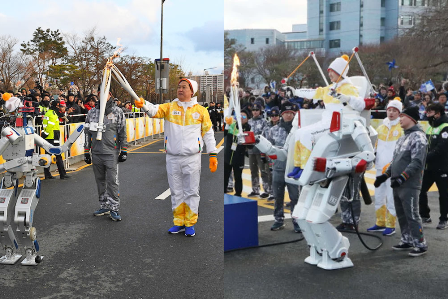
HUBO is a humanoid robot who was put through his paces; his first task was to drive a vehicle to an obstacle course. (His passenger was Dennis Hong, the Professor of the project.) When they arrived HUBO carried the flame towards an obstacle that lay before him.
Thereafter, he went on to demonstrate his usefulness as a rescue operation robot; HUBO drilled a hole in a wall; a hole through which he passed the Olympic torch.
The torch was then handed to a 14-year-old aspiring engineer who sat atop a human-operated-robot named FX-2. Professor Hong explained that the robots involved in this Olympic Games showcase how far robotics has come; they also reveal what we can expect in the future.
During the actual Games there will be 85 robots hard at work. Not all will be like HUBO, there will be 11 robot types assisting with a range of tasks. Some will clean floors, others will deliver things, and those with linguistic talents will offer directions to the spectators - in Korean, Chinese, Japanese and English.
Some of the robots even have creative ability; they will paint murals on the venue walls.
These robots are all controlled by the engineers at the Korean Advanced Institute of Science and Technology (KAIST).
Constructions, slopes, and snow
Korea’s largest steelmaker, Posco, contributed to the construction of facilities wherein the Games will be held; they have built the “International Broadcasting Center, media residence” and the “Gwandong Hockey Center”.
All in all, twelve facilities will be utilized during the Games, making these Winter Olympics the largest ever. Six older facilities have been refurbished and six are newly constructed. South Korea has also been congratulated for completing all necessary construction six months in advance of the Games.
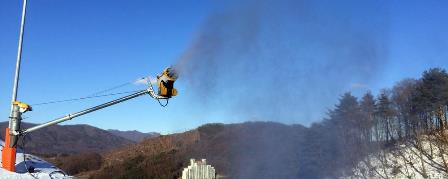
TechnAlpin is the company responsible for the condition of the snow on the slopes. It has also assisted in the upgrade of the ‘snow-making systems’ at the two main venues. These venues will host the ‘skiing, alpine, snowboard and freestyle’ competitions.
TechnoAlpin installed the original systems back in the 1990s; now they have been upgraded to work around the clock during the Winter Olympics. 250 snow guns will spread snow around the various courses; they will be powered by three pumping stations and overseen by snow-making consultant Davide Cerato.
CEO of TechnoAlpin, Erich Gummerer said: “We are very proud to have been entrusted with providing guaranteed snow for the Winter Olympic Games in Pyeongchang.”
In conclusion, all of us at the Engineering Institute of Technology would like to wish all competitors the best of luck. We also earnestly hope that the Games can indeed be a time of friendly rivalry and healing between nations. And finally we congratulate and thank the engineers and technicians whose hard work makes such an event possible.
Works Cited
Herald. “Posco's Premium Steel, Engineering Solution Used for PyeongChang Olympics.” The Korea Herald, 20 Dec. 2017, www.koreaherald.com/view.php?ud=20171220000826.
Tousignant, Lauren. “A Robot Carried the Olympic Torch in South Korea.” New York Post, New York Post, 12 Dec. 2017, nypost.com/2017/12/12/a-robot-carried-the-olympic-torch-in-south-korea/.
A speech to EIT students embarking on their studies: February 2018
Good morning Ladies and Gentleman
As I stand in front of you I am sure you are contemplating the years stretching ahead with a mixture of excitement and apprehension; wondering what they will bring you. To come to a strange country and to commit to this challenge is brave, well done! We would like to welcome you warmly to our college.
There are four things I would like to talk about today:
- Our proud history
- The Ethos of the Engineering Institute of Technology
- Why attending college is a great decision
- Some suggestions and points to take-away with you
Our Proud History
We were founded in 1992 so have a proud history extending over 27 years. During that time we have trained over half a million engineering professionals on our short courses and currently, on our online engineering diploma and degree programs, we have around 1500 students based in over 140 countries. We also have corporate clients who use our training and education, smaller firms and blue chip companies such as BP, NASA, Rolls Royce, the US Army, BHP Billiton and Rio Tinto.
Our focus and passion is engineering and technology; we love nothing more than demonstrated excellence in these areas. But we realise too that it is essential to communicate well and to develop an understanding and admiration for the Arts and Philosophy. I believe a well-rounded, positive individual who is open to learning will get the most out of Life.
The Ethos of the Engineering Institute of Technology
EIT is unique and markedly different to other institutions and this is why:
- We are a college which is 100% devoted to engineering and technology;
- We have highly experienced and dedicated engineers and technologists lecturing for us;
- We keep our class sizes small because we want to ensure your success;
- We aim to educate individuals - not just a group – because we are interested in each of you;
- Whilst we undoubtedly undertaken research; we are 100% focussed on excellence in teaching and learning unlike most of other institutions who have to compromise;
- We have incorporated online education into your classroom to expose you to international engineering expertise and the modern 21st Century world;
- We will ensure you receive practical, useful and cutting-edge content to better prepare you for work and a career in engineering (Our 1500 students are, by and large, working in industry in well-paying jobs);
- We have worldwide accreditation and endorsements for our programs;
- We have extensive opportunities for professional development and life-long learning (for well after you finish your degree with us);
- We are flexible and nimble; we continuously improve our content to keep up with the changes in industry and we regularly add new topics to our array of courses and qualifications.
You may wonder if you have made a good decision – is a college qualification worthwhile?
I believe the answer is a resounding ‘YES’ (But then, as Dean of your college, with a few degrees behind my name, I would have to say that wouldn’t I?)
Despite this, your decision is an intelligent one; it will most certainly hold you in very good stead. At college you have the opportunity to learn, to acquire new knowledge and skills. This is a privilege, but it is also designed to help prepare you for your career, or to boost it. (Studies clearly indicate that college graduates earn more than those who choose not to attend.)
You will also make new friends – both here and out there in Perth and beyond. This is important for you personally (and potentially for future networking).
I would urge you to do your very best while you are here. Stretch yourselves, work hard and use all your experiences, socially and academically, to help you fulfil your potential and your dreams.
Some suggestions
Australia
Australia is a marvellous country populated by a wonderful mix of cosmopolitan people. Most of us are immigrants, originally from another part of the world. Australians love to give everyone a ‘fair go’; they love sport and the ‘larrikin’ spirit. It is also a highly regulated country – as you would have discovered already through your visa process. Thanks to this careful regulation and a strong social awareness you will notice that crime is low here – it still happens, but it is low. It is a very positive caring environment in which to live. You may, however, find the socialist ideals difficult to adjust to. Or you may love them. Naturally, as is the case in every society, there are those who hate the systems and structures; all we can do is to remain positive in the face of their anger.
Think Globally
We live in a global village. If you owned the corner fish and chip shop, for example, the price of potatoes in another country could force your costs up (or indeed allow you to lower them). There are many factors which impact us as global citizens: climate change, sustainability, the cost of energy and pollution. Your engineering career should be thought of in exactly the same way. You will be capable of working anywhere in the world; in fact the company you ultimately work for will, more than likely, have international partners in other countries.
STEEM Ahead
Recently I was sharply corrected by a good engineering colleague of mine when I used the term STEM (Science, Technology, Engineering and Maths). He suggested an improved acronym: STEEM – to include entrepreneurship. And he is absolutely right.
The evidence of a rapidly changing jobs market is clear. A ‘job for life’ is no longer an option and increasingly automation is hollowing out traditional employment in many industrial facilities. Technologies that once were buzzwords are now being successfully implemented and providing huge opportunities for would-be entrepreneurs: machine learning, artificial intelligence, robotics, the Internet of Things, cybersecurity, cloud computing and virtual reality.
These changes make it critical that we all become entrepreneurs; we need to learn to think as entrepreneurs, to focus on creativity and business outcomes. And in this we also need to tolerate failure and learn from it. It doesn’t mean that you should set up a business, but that you should always think of yourself as an entrepreneur — even when working within a large company.
Learning is Life-Long
Rapidly changing technologies mean that acquired information loses its relevance and applicability more quickly than ever before. This can be daunting and slightly disheartening, but it needn’t be. Be open to learning. Formal education is one thing, but informal learning is often more powerful. You may recall in times gone past the very powerful learning models with the master craftswoman training her apprentice to be an outstanding professional. Similarly, you will find expertise available informally which you can draw on and make your own. Traditional college and vocational education will be unrecognisable in the next decade with the incredible opportunities presented by the internet and training companies arriving on the scene.
Take Responsibility for your Learning
Up until this point most of you would have had a largely structured education. At college you will find it less so. Yes, we have the clear learning objectives for each unit, but we want you to go well beyond these goals, we want you to reach for the stars. You will be expected to become self-reliant and independent in your thinking and learning. Develop good study habits, work hard and be disciplined in your approach to your education. Learning without rigour and merely hoping for the best is a sure fire recipe for failure. Talk to us if you find topics difficult; don’t wait until it is too late. We are determined that you succeed. You are extraordinarily important to us.
Critical Thinking
Colleges and Universities encourage critical thinking and debate because education is not about indoctrination. I have encouraged you to be structured in your approach to your studies, but be cautious; don’t develop a fixed mind set. It is vital that you question everything that you are taught. We will undoubtedly stretch you in your thinking and work here. Bear in mind that some of the most successful technologists in the world dropped out of their studies - luminaries like Bill Gates, Steve Jobs, Elon Musk and our mentor, until his recent death, Dick Morley – who founded a trillion dollar automation business.
You Never Arrive
Please always remember that it is the journey that is important, not some envisioned destination. Enjoy each day; draw maximum value from every one of them and contribute your absolute best. Try and support your fellow travellers on the journey – whilst we are looking for individual effort – you will personally gain enormously by helping others. We look forward to accompanying you on your journey.
All the best for a barnstorming 2018. Focus on hard objectives now to ensure your time here exceeds all your expectations. Above all, stay healthy and stay personally connected.
On behalf of us all I wish you the heartiest of welcomes to the Engineering Institute of Technology.
Steve Mackay PhD
Dean of Engineering

At a recent function for would-be students of our engineering college on the need for more of a STEM focus, I was sharply corrected by a good colleague who remarked that we should think rather of STEEM: science, technology, engineering, entrepreneurship and mathematics. And he is so absolutely right.
My take on the industrial automation industry in Australia is that we do not have enough entrepreneurial activity with a global focus. With the huge downsizing in employment at the large Australian mining and manufacturing companies, we need other entrepreneurial ventures to take up the employment slack in the engineering industries. For example, an inspirational Australian entrepreneurial company in the industrial automation sphere that I once worked for embraced this and went onto huge success globally: Citect (now part of Schneider Electric) created world-class SCADA software that took the world by storm.
The evidence of a rapidly changing jobs market is plain for everyone to see. We have known for the past two decades that there are no longer ‘jobs for life’. Now we are increasingly seeing that automation has hollowed out the number of people required in any industrial facility. Technologies that once were buzzwords are now being successfully implemented and providing huge opportunities for would-be entrepreneurs: machine learning, artificial intelligence, robotics, Internet of Things, cybersecurity, cloud computing and virtual reality.
It is thus vital that everyone jumps on board this train of entrepreneurship. We need to encourage everyone from the time they enter school to think as entrepreneurs, with a strong focus on creativity and business outcomes — and also tolerance of failure. This doesn’t necessarily mean that you should set up a business, but that you should always think of yourself as an entrepreneur — even when working for a large mining company.
Without a shadow of doubt, engineering professionals are brilliant problem-solvers; however, you need to go well beyond this to be successful as an entrepreneur with an appetite for risk-taking. Engineers often mistakenly believe that creation of the technology is the hard bit and taking the product to market is the easy part. Everyone is fixated on ‘cool ideas and technology’. However, this is a very small part of the story: commercial viability is absolutely critical, and trying to understand what the market wants is key to success.
The old adage ‘Build a better mousetrap, and the world will beat a path to your door’ is sadly not true. Powerful selling and marketing are key elements in making a product successful. Elements such as product functionality can only be gauged by engaging with the market.
The financial side of the business is also critical. Pricing the product just right is essential. The business model has to stack up and you need to have a clear idea of who your ultimate customers are and what their needs are.
With the world economy bouncing back (and mining back in vogue again), technology change accelerating and the internet reducing the barriers to entry, now is the time for Australian would-be entrepreneurs — especially in the industrial automation space — to satisfy this huge raft of new demands out there.
All the best for a barnstorming 2018. Focus on hard objectives now to ensure it exceeds all your expectations. Above all, stay healthy and stay happily personally connected.
Source Westwick-Farrow Media Process Online
The Winter Olympics are upon us. The opening ceremony airs on February 9th, 2018. Over the course of the competition in Pyeongchang, South Korea, the feats of many engineers will be on display too. In fact it will be hard to find an event untouched by engineering. (Some of the athletes themselves even have engineering degrees.)
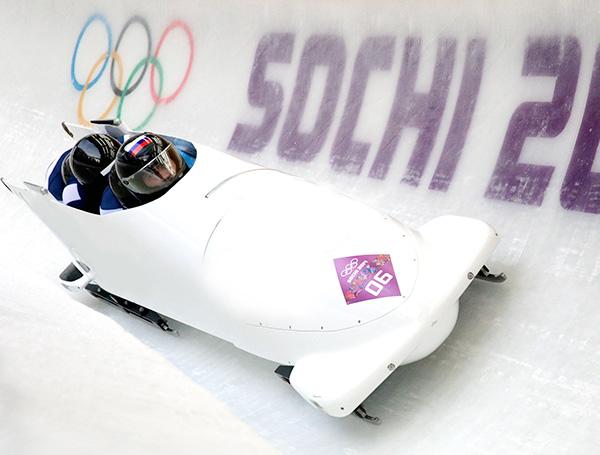
One of the competitions at the Winter Olympics that should get pulses racing is bobsleigh. It is also known as Formula One on Ice because the engineering teams behind Formula One vehicles design the bobsleds.
Reuters spoke to Rachel Blackburn, the engineer who has presided over Britain’s bobsled program since 2003. She works for supercar manufacturer McLaren.
She says car companies have historically become involved with bobsleigh competitions because it is a fun way to test aerodynamics. It helps to create data that may help them engineer other products for other industries. She told Reuters:
“Applied engineering is far more interesting than the pure stuff, so when it’s applied to something that’s fun and exciting it does make it a lot easier to solve the problems. There is Americas Cup, sailing, Formula One and the high speed ice sports as well. It’s the same concept. In the skeleton we’re looking at chassis dynamics, it’s not dissimilar.”
BMW, who have been hard at work designing the most premium bobsled for the Pyeongchang Winter Olympics, have been utilizing their wind tunnels - normally used for cars - to improve their bobsled. These days, however, before creating the prototype bobsled a round of computer simulations occur.
Holger Gau, BMW expert for 3D simulation methods told The Drive.com:
“We can optimize the bobs here in exactly the same way as we optimize our cars. We look at turbulence, analyze pooling regions and use appropriate shape changes - or changed seating positions - to try and minimize resistance. We use high-performance software tools to evaluate the aerodynamics of the combination of the bob and the team, and to optimize this virtually. Then the verification and fine-tuning takes place in the wind tunnel. It’s all about finding the optimum way to interlink the advantages of both worlds - digital and real-time in the wind tunnel.”
The times are a-changin?
Whilst the advent of 3D printing (rapid prototyping) vastly improves the manufacturing process and end product efficiency of bobsleds, there is one element of the vehicle that is hampering its innovation.
The chassis is a steel chassis. Thus, whilst the body and other elements can be rapidly prototyped, the chassis is still made from steel. Blackburn says:
“The fact that we still limit things to steel makes it quite a lot trickier for small nations now to get things made, especially to the precision that skeleton sleds require given the speeds and the temperatures they are going through.”
Whilst steel innovation may be painstaking, the same cannot be said for the bobsleigh course. Researchers at Purdue University in the US suggest that instead of iced bobsled tracks the future material for the course could be plastic. And this innovation may be introduced soon after these Winter Games.
Jan-Anders Mansson, a Professor in Materials and Chemical Engineering, and the Director of the Composites Manufacturing and Simulation Center at Purdue University, explains that the bobsled tracks are used only rarely. And they are expensive. According to PHYS.org the track built for the Turin Olympics in 2006 cost US$100 million. A plastic course, today, would only cost US$5 million.
Thus, Mansson conducted three years of research into ‘ultra-high molecular weight polyethylene’. He found that when the plastic was coated with a light spritz of water over a kilometer track of the plastic, it could produce the exact kind of conditions bobsleds need to perform.
Talking to PHYS.org, Mansson said the polymer was also self-healing and would not be fatally damaged by bobsleds passing over it. He says the discovery could open the sport up to children around the world. He said:
“The goal for any sport is to get kids in there and they start to compete, and the interest grows. If you do this not with ice but with plastic that has the same properties, you can have summer bobsledding, family bobsledding and even large events in warm countries.”
Works Cited
Bartosiak, Dave. “BMW Designs Bobsleigh for German Olympic Team.” The Drive, 9 Jan. 2018, www.thedrive.com/sheetmetal/17515/bmw-designs-bobsleigh-for-german-olympic-team.
“Future Bobsled Competitions May Be Sliding toward Plastic Ice.” Phys.org - News and Articles on Science and Technology, phys.org/news/2018-01-future-bobsled-competitions-plastic-ice.html.
Rutherford, Editing by Peter. “Formula 1's Bobsleigh Input Helps Make an Ice Runner.” Reuters, Thomson Reuters, 8 Jan. 2018, www.reuters.com/article/us-olympics-2018-bobs-f1/formula-1s-bobsleigh-input-helps-make-an-ice-runner-idUSKBN1EX17H.
The future is yours for the taking.
This good ole’ adage has driven many into PANIC MODE; there is undue stress for young people when it comes to picking a vocation.
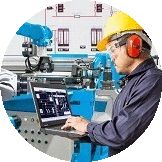 A fresh batch of school-leavers have just begun their academic year and many will have chosen the discipline of engineering – they will be wondering which field of engineering will best suit them and provide them with good job prospects.
A fresh batch of school-leavers have just begun their academic year and many will have chosen the discipline of engineering – they will be wondering which field of engineering will best suit them and provide them with good job prospects.
Engineering graduates should reassure these undergraduates with the following advice: find your way into engineering education and focus on establishing a ‘broad scope’ of skills necessary for working in interdisciplinary industries.
School-leavers and prospective engineers and technologists are facing a new reality: they may find jobs in engineering industries they were not expecting to get into. And many will change direction during their careers or become more proficient in a field of engineering that they did not study.
Some school students believe that the science and math they learn at school will define the engineering streams they select and the jobs they get. Whilst the cognitive benefits of grasping high school math and science are advantageous, the reality is that the science and math that graduates end up grappling with in their engineering careers may be wholly different.
One degree, plenty choices
Perhaps there are some engineering courses that have more variety and versatility than others. An alleged engineer on social media site Reddit, ‘abadonn’, thinks Mechanical Engineering provides a pathway into many different industries. He writes:
“Mechanical engineering. It’s probably the broadest of all career choices. We learn a bit of everything: MatSci, EE, Math, Structural, Thermal, Programming, etc. And if you want to specialize you can always go get a masters. I work for a large biomed company that probably hires more mechanical engineers than biomedical engineers.”
Some engineers are determined to ‘follow the money’. The biomedical engineering industry is becoming one of the most lucrative engineering industries due to wearables and automation making its way into the industry. These technological developments ensure that many different types of engineering disciplines plug into the biomedical industry. There does, however, need to be a certain amount of caution when selecting a way forward. In many countries a biomedical engineering graduate may only find maintenance work in his/her field, with few opportunities for design.
Engineer + travel = happiness
Engineering can come with travel benefits with – engineers (depending on what and where their credentials have been gained) are often deemed globally relevant to many job markets.
In Australia, at mining companies like Rio Tinto, many engineering professionals form part of a FIFO (fly-in-fly-out) program. Engineers are flown in to work for a stretch of time (accommodation is provided for them), the company then flies them home for a patch of time before they again return to site.
Some engineers opt to immigrate to other countries and take their expertise elsewhere. Some fortunate engineers even take their expertise to Antarctica.
South Africa, for example, has a little known South African National Antarctic Programme. The program is run in conjunction with the South African National Space Agency. Yearly, South African engineers and science professionals descend on Antarctica to assist with Space Weather Research. We talk to an electrical engineer who overwintered at the SANAE IV base in Antarctica:
Engineers with a ‘can do’ attitude, who also want travel benefits, could find themselves in the pound seats. And in many instances, accomplishing life-changing work.
Works Cited
“What Engineering Discipline Did You Specialising in/Are Studying and Why? • r/Engineering.” Reddit, www.reddit.com/r/engineering/comments/wp437/what_engineering_discipline_did_you_specialising/.
New data generated from the U.S. Department of Transportation has revealed that more than 54,000 American bridges are structurally deficient. America has 612,677 bridges.
Americans cross these bridges 174 million times daily.
One in three bridges are in need of repair, and one in three Interstate highway bridges have also been flagged as needing maintenance.
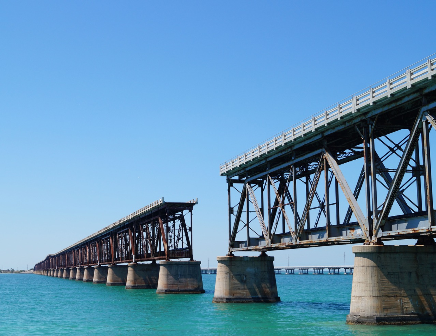
Dr. Alison Premo Black, Chief Economist for the American Road & Transportation Builders Association, who led the research, said that it would take 37 years, at the current rate of repair, to fix or replace structurally deficient bridges in America.
The figures were released just in time for the President of the United States Donald Trump’s State of the Union address. In the address, he suggested that what America needs is a US$1.5 trillion in investment into infrastructure in the next decade. President Trump said:
“Together, we can reclaim our great building heritage. We will build gleaming new roads, bridges, highways, railways, and waterways all across our land.”
President Trump has encouraged Congress to stimulate the budget for the infrastructural maintenance required to fully restore America’s infrastructure. Jason Lange, a reporter at Reuters, says that the situation is not as bad as President Trump asserts. Lange said:
“The view that roads, bridges, other pieces of U.S. infrastructure are failing, they’re crumbling - it’s a bit overblown. We’ve analyzed federal data on highway bridges; there’s more than 600,000 of them. And, about just under 9% are deemed structurally deficient, which means, they need repairs. That sounds like a large number, but actually, it’s been falling for decades. It was above 20% in the early 1990s.”
He also says that only 4% of the bridges that see the highest number of daily crossings are in need of repairs – a fairly low number. But the bridges that have failed in the U.S. have reportedly been those with the least daily crossings.
How to keep the built environment in the U.S. structurally sound is complex.
Historical infrastructural shortcomings
In 2007, with the collapse of Mississippi’s I-35W bridge, it was evident that America had a crumbling infrastructure problem. The collapse caused the deaths of 13 people.
When Hurricane Harvey descended on the U.S. in August 2017, America’s infrastructure shortcomings were highlighted once again. You can read our report here: Hurricane Harvey: Engineering industries confront the flooding and infrastructure needs for the future. Floods due to bad storm water draining is something that New Orleans still struggles with to this day - even after the lessons supposedly learned after Hurricane Katrina.
It has been a problem that has persisted, and is something that President Trump has promised he would rectify. The American Society of Civil Engineers has asserted that water facilities may need more attention than bridges in the short-term.
The silver lining: engineers and industry workers will be employed in the next ten years - working to strengthen America’s infrastructure. There may not be a trillion dollars of investment, but what engineers can be sure about, is that they will share in billions of dollars in infrastructure investment in the next decade. It is something America sorely needs - both Democrats and Republicans agree about that.
Works Cited
American Road & Transportation Builders Association. “Over 54,000 American Bridges Structurally Deficient, Analysis of New Federal Data Shows.” PR Newswire: News Distribution, Targeting and Monitoring, 29 Jan. 2018, www.prnewswire.com/news-releases/over-54000-american-bridges-structurally-deficient-analysis-of-new-federal-data-shows-300589542.html.
Lange, Jason, and Katanga Johnson; “Crumbling Bridges? Fret Not America, It's Not That Bad.” Reuters, Thomson Reuters, 31 Jan. 2018, www.reuters.com/article/us-usa-trump-bridges/crumbling-bridges-fret-not-america-its-not-that-bad-idUSKBN1FK0J0.
It may be a landmark year for Indian engineering. This year, at the end of March, India’s Space Research Organization (ISRO) will land an unmanned rover on the moon.
They will be sending an orbiter, a lander, and a rover in what it is being called the Chandrayaan-2 mission. Directly translated, using a combination of Sanskrit and Hindi, Chandrayaan means ‘Moon Vehicle’. ISRO has sent an orbiter around the moon before, but eventually lost contact with it.
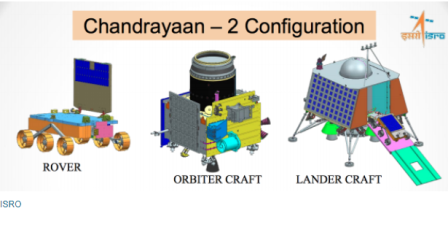
The project’s cost has seen many estimates; some suggest it will be US$93 million, whilst others say US$70 million. For comparison sake, the Chandrayaan-1 mission, which only orbited the moon, cost $83 million in 2008.
Nonetheless, ISRO are hoping to challenge their engineers quite significantly in the next few years; they hope to launch a satellite on a 5-year journey to study cosmic radiation after their lunar mission.
Engineering education
It was estimated by the International community Empowerment Foundation Monitor that, with China, India would produce 40 percent of global STEM graduates by 2020. However, education experts are reporting that graduates from India are not being ably prepared for the job market.
According to the Deccan Chronicle, 1.5 million engineering graduates are produced in India every year, but more than half of them do not find jobs in the industry. Professor Venkata Gaddam Reddy, an education expert, said:
“About 80 percent of engineering graduates are not employable because of poor quality, shortage of quality faculty, inadequate funds and infrastructure, lack of practical training or industry internships and no research activities.”
Varun Aggarwal, co-founder of Aspiring Minds (an online psychometric and aptitude testing company), and author of the book ‘Leading Science and Technology: India Next?’ agrees that India lacks engineering research role models. He told Economic Times India:
“While the government is emphasizing the need to build focus on research and development for gaining competitive edge on the global forefront, there are very few scientists and researchers who emerge as public role models.”
These revelations were highlighted in a new study that revealed that only 3 in 10 engineering graduates from India have any knowledge of international researchers or research journals in their field of study. Students reported that engineering course curricula did not truly align with the practical requirements of the engineering industry.
The government in India is trying to stymie the creation of new engineering colleges. They have encouraged the All India Council for Technical Education (AICTE) to prevent new engineering colleges from being approved in 2018; there are very low attendance figures in the technical courses that already exist.
What remains clear is if India wants well-qualified engineers that can continue to develop spacecraft for their space organization and for their engineering industries generally; they have to solve the current crisis in their engineering education and training.
Works Cited
“China and India to Produce 40% of Global Graduates by 2020.” ICEF Monitor - Market Intelligence for International Student Recruitment, 14 Jan. 2016, monitor.icef.com/2012/07/china-and-india-to-produce-40-of-global-graduates-by-2020/.
“Engineering Graduates Have Poor Awareness of Research: Study.” The Economic Times, 29 Jan. 2018, economictimes.indiatimes.com/jobs/engineering-graduates-have-poor-awareness-of-research-study/articleshow/62700657.cms.
Puppala, Anusha. “Hyderabad: Engineering Overhyped; Quality Takes a Beating.” Https://Www.deccanchronicle.com/, Deccan Chronicle, 28 Jan. 2018, www.deccanchronicle.com/nation/current-affairs/290118/hyderabad-engineering-overhyped-quality-takes-a-beating.html.
The largest manufacturing plant in the world is in Wolfsburg, West Germany. It is a car manufacturing plant that belongs to none other than Volkswagen. It covers an area of 6.5 million square miles. It is so vast that employees are able to cycle around the company’s main headquarters.
The houses surrounding the factory are filled with Volkswagen employees, and whoever else lives there is in some way or another associated with the car manufacturer.
Volkswagen beat Toyota in sales, becoming the largest automaker of 2017.
The company is no doubt an engineering giant. However, Volkswagen’s global stature has afforded the company the freedom to do as they please in the automaker industry. This was highlighted when three students exposed Volkswagen for cheating on nitrogen oxide emissions tests in what would become known as the Dieselgate Scandal. You can read the story here: The College Students Who Exposed Volkswagen.
After Volkswagen had apologized for their unethical behavior of underreporting nitrogen oxide levels with illegal defeat devices within their vehicles, they might have thought the nastier details of how they tried to cheat emissions tests would have disappeared. Unfortunately, for them, they have not been so lucky.
Dieselgate Continues
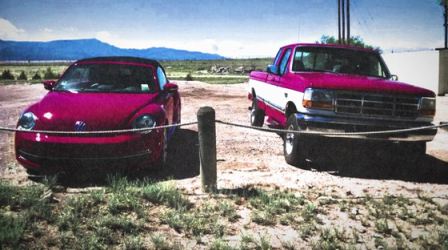 According to newly released Netflix Documentary, Dirty Money, Volkswagen conducted emissions tests on monkeys in 2014 to try and prove their TDI vehicles were environmentally safe.
According to newly released Netflix Documentary, Dirty Money, Volkswagen conducted emissions tests on monkeys in 2014 to try and prove their TDI vehicles were environmentally safe.
Volkswagen reportedly started a fake non-profit company named the European Research Group on Environment and Health in the Transport Sector (EUGT). The company paid north of US$700,000 to another company called Lovelace Respiratory Research Institute (LRRI) - a company that would go on to test BMW, Mercedes-BEnz and VW cars’ diesel exhaust emissions.
Michael Melkersen, the attorney who uncovered VW’s unethical behavior - revealed that VW were going to take their TDI engines and pit them up against old diesel technologies and compile reports to show that VW’s engines were more environmentally friendly.
James Liang, an engineer working in the Office of Diesel Competence at Volkswagen America, who had a hand in setting up the defeat devices that were named and shamed in the Dieselgate Scandal, also had a hand in the animal testing scandal that has now been revealed.
Liang delivered a VW TDI Beetle to a research facility owned by LRRI. They were going to compare the Beetle’s cleaner diesel technology to the older technology belonging to the 1997 Ford F250’s emissions. How they proposed to show the TDI cars were less harmful to human beings and more environmentally safe was shocking - to say the least.
The experiments
Michael Melkersen, talking to the filmmakers of Netflix’s Dirty Money, said:
“In the original draft of the study, they were actually going to have a human sitting on an exercise bike - and there’s actually a diagram of this in the proposal - where a human participant would sit riding an exercise bike and they would then be exposed to gas directly from the diesel vehicles. Then, they would poke and prod that person later to determine what type of health effects they would see from this person being gassed.”
It is not known if Volkswagen tested emissions on any humans, but they have apologized for tweaking the experiment to test the diesel emissions on monkeys. LRRI eventually compiled the report; with the heading reading: Exposures to Diesel or Alternate Technology Emissions to Evaluate Biological Response in Non-Human Primates (NHP).
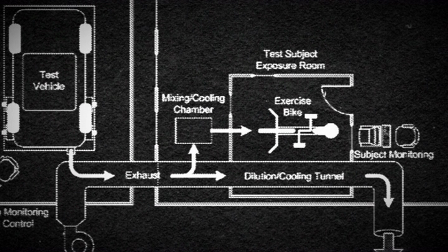 Volkswagen engineers pumped diesel emissions from the new TDI Beetle and Ford F250 into sealed cages with distracted cartoon-watching monkeys. Each test reportedly went on for hours. The New York Times confirmed that illegal cheating software was used on the TDI Beetle for the experiment. The TDI cars named in the Dieselgate scandal reported 80 times the legal limit of nitrogen oxide emissions.
Volkswagen engineers pumped diesel emissions from the new TDI Beetle and Ford F250 into sealed cages with distracted cartoon-watching monkeys. Each test reportedly went on for hours. The New York Times confirmed that illegal cheating software was used on the TDI Beetle for the experiment. The TDI cars named in the Dieselgate scandal reported 80 times the legal limit of nitrogen oxide emissions.
The New York Times reports that Volkswagen had begun funding EUGT as early as 2007. Daimler AG, who own BMW and Mercedes-Benz have distanced themselves from the practices. In a statement to media, they said: “Daimler does not tolerate or support unethical treatments of animals.”
Volkswagen said: “The scientific methods used to conduct the study were wrong. Animal testing is completely inconsistent with our corporate standards. We apologize for the inappropriate behavior that occurred and for the poor judgment of individuals who were involved.”
Works Cited
“Dirty Money.” Netflix Official Site, 26 Jan. 2018, www.netflix.com/za/title/80118100.
Ewing, Jack. “German Carmakers Criticized for Emissions Research on Monkeys.” The New York Times, The New York Times, 28 Jan. 2018, www.nytimes.com/2018/01/28/business/german-carmakers-diesel-monkeys.html.
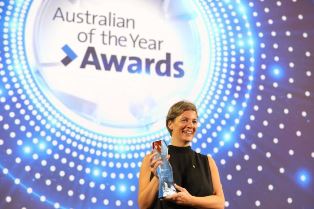
Professor Michelle Simmons is the most recently crowned Australian of the Year. A true testament to quantum physics, science more broadly, women, and Australia - we take a quick look at Simmons' work, and the achievements that led to her becoming the recipient of this most prestigious award.
The British born quantum physicist moved to Australia in 1999 and has never looked back. She cites the curious and driven attitude of scientists here and their willingness to collaborate as some of the perks of conducting research down under.
Her long term goal is to invent the quantum computer, and progress is looking very promising so far. In 2012 Michelle and her team worked to create the world's first single atom transistor, an astounding 4 atoms wide. The transistor is a vital step for reading and and controlling 'qubits', the unit of measurement in all things quantum. Currently based at UNSW, Michelle founded Silicon Quantum Computing in 2017, the first ever quantum computing company on Australian shores.
On a recent interview on RN Breakfast following the AoTY ceremony last Thursday, Simmons explained to host Fran Kelly some of the finer points in her complex field of expertise. Where classical computing works by following one item of code after another, quantum computing works in parallels. Wherever there is a large quantity of data, potentially with many variables, a quantum computer could translate it into real world data instantaneously. This would rapidly increase efficiency in an array of systems used daily on a global scale. Think weather prediction, drug study and design, predicting traffic and cutting fuel costs, to name a few.
On a personal level, Simmons is a believer in perseverance and "doing things that are hard, as they are the most rewarding". She intends to use her platform as Australian of the Year 2018 to encourage young Australians to interrogate the world around them and create new technologies. She also wishes to promote women in quantum physics, with a mere 5% of the industry being female.
Sources:
ABC Radio National. (2018). Quantum physicist Michelle Simmons named Australian of the Year. [online] Available at: http://www.abc.net.au/radionational/programs/breakfast/quantum-physicist-michelle-simmons-named-australian-of-the-year/9364234 [Accessed 29 Jan. 2018].
Purdue University. (2012). One and done: Single-atom transistor is end of Moore's Law; may be beginning of quantum computing. [online] Available at: http://www.purdue.edu/newsroom/research/2012/120219KlimeckAtom.html [Accessed 29 Jan. 2018].
The Conversation. (2018). Award to Michelle Simmons reflects strategic importance of quantum physics for Australia. [online] Available at: https://theconversation.com/award-to-michelle-simmons-reflects-strategic-importance-of-quantum-physics-for-australia-90759 [Accessed 29 Jan. 2018].
The Chinese may be on their way to setting a new world record...for a railway construction job in the Fujian Province in Southern China.
On the 19th of January 2018 something quite remarkable happened when 1,500 workers were tasked with constructing a railway designed to connect the city of Longyan to three other pre-existing railways.
It was successfully completed in nine hours! From the evening of the 19th of January to the early hours of the 20th the teams worked through the night - showing off Chinese efficiency in a big way.
The all-nighter also included the installation of traffic signals and monitoring equipment.
Words may do this incredible feat of engineering a disservice. Look at this video to see the sheer spectacle of it:
The newly built Nanlong Railway will connect to Ganlong, Ganruilong, and Zhanglong railways. It is to become the main railway that links south-east China with Central China, reports Xinhua news.
Seven teams, working simultaneously, utilized the strength of 23 diggers and 7 trains to start the project which is expected to be completed at the end of 2018. If they work with this kind of stamina the project deadline will be achieved.
Chinese New Year
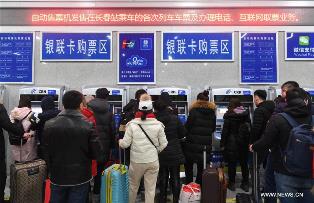 China depends on trains. On Friday 16th February 2018 China will observe their New Year. It is a time that signals travel, the Chunyun travel period or Spring Festival. People migrate to be present at the festival and to reunite with family in their original homelands. Chunyun will see 3 billion trips made between January 13th and February 21st. Of these, 300 million will be taken by train.
China depends on trains. On Friday 16th February 2018 China will observe their New Year. It is a time that signals travel, the Chunyun travel period or Spring Festival. People migrate to be present at the festival and to reunite with family in their original homelands. Chunyun will see 3 billion trips made between January 13th and February 21st. Of these, 300 million will be taken by train.
The China Railway Corporation’s website will be inundated, processing ticket sales, leading up to this period.
Zhu Jian Sheng, the associate director of the Institute of Computing Technologies at China Academy of Railway Science says:
“The average page views for 12,306 (the website) is 55.67 billion views per day and 81.34 billion views per day during the peak period. The highest clicks per hour is 5.93 billion with an average of 1.648 million clicks per second.”
The corporation will sell 10 to 15 million tickets a day on the lead up to Chunyun. Engineers are naturally on standby to ensure the efficiency of transportation and to repair any faults that may manifest during the 40-day holiday.
We wish all those celebrating the Chinese New Year a happy season and successful year ahead.
Works Cited
Tomarnstein. “China Railway Site Sees 5.93 Billion Clicks Per Hour as Busiest Travel Season Starts.” Tomarnstein, The Beijinger, 17 Jan. 2018, www.thebeijinger.com/blog/2018/01/18/china-railway-site-sees-593-billion-clicks-hour-busiest-travel-season-starts.
彭莹 . “Railway Project Involving 1,500 Workers Completed in Less than 9 Hours.” Railway Project Involving 1,500 Workers Completed in Less than 9 Hours - Xinhua | English.news.cn, www.xinhuanet.com/english/2018-01/23/c_136917236_2.htm.
National Society of Professional Engineers, American Society of Civil Engineers, Engineers Without Borders, American Nuclear Society, American Society of Safety Engineers, Biomedical Engineering Society, Institute of Transportation Engineers, Society of Manufacturing Engineers, Order of the Engineer, Institute of Industrial and System Engineers.
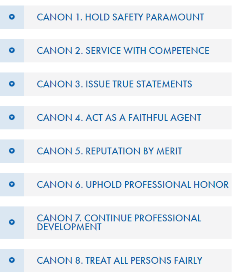 This is enough to make your head spin. The aforementioned engineering societies are only a portion of those that exist in the United States alone. Each has a set of rules, specific creeds, managerial structures etc.
This is enough to make your head spin. The aforementioned engineering societies are only a portion of those that exist in the United States alone. Each has a set of rules, specific creeds, managerial structures etc.
Source: American Society of Civil Engineers
Engineering societies do have merit; they hold engineers to a level of professionalism and they help to keep them ethical. The American Society of Civil Engineers, for example, has a good code of ethics that engineers in other industries could also benefit from.
And the National Society of Professional Engineers promises to do ‘everything that can be done’ to ensure engineering industries are transparent, ethical, and organized - in order to protect the engineering profession itself.
In today’s world, however, membership is dropping away. Often the only motivation to join one is because of the belief (misguided perhaps) that it will secure the member a job in industry.
On the social media site Reddit a user highlighted the issue. He reported that at the local American Institute of Aeronautics and Astronautics corporate board meeting the turn-up was poor. He went on to write:
“The older guys claimed that 10 years ago the chapter was full of life, with 30-40 members attending tours/lectures several times a year. But now, the local chapter is functionally an organization of officers.”
A popular response to the post speaks volumes: Jadbal wrote:
“Back when engineers would start at a company fresh out of college, and stay their whole career, it made sense to join a professional organization and attend regularly. Now, we move every two to three years for the first decade of our careers. Hard to get involved when you don’t know where you’ll be in six months.”
Build your own society
Joining an engineering society and being a name on an emailing list is no longer a functional way of keeping up to date with peers within the industry. Historically, societies provided engineers with internship opportunities and some even found jobs from being closely linked with other engineers in their disciplines.
Now with social media services like LinkedIn, engineers, on top of their already premium set of skills, are learning how to network in a different forum.
Keeping a virtual (or real) rolodex of names and numbers and acquaintances in the industry is a far better strategy. Engineers are more mobile so need the flexibility of networking online. And there is another reason contributing to the drop-off in membership: some societies charge monthly fees. Admittedly they often have the authority to confer ‘chartered status’, but projects demanding this elite status are also dwindling.
Society member or not, the following is a wholesome reminder of what it means to be an engineer. It is an oath and is called the ‘Obligation of an Engineer’.
“I am an Engineer. In my profession I take deep pride. To it I owe solemn obligations.
As an engineer, I pledge to practice integrity and fair dealing, tolerance and respect; and to uphold devotion to the standards and dignity of my profession, conscious always that my skill carries with it the obligation to serve humanity by making the best use of the Earth's precious wealth.
As an engineer, I shall participate in none but honest enterprises. When needed, my skill and knowledge shall be given without reservation for the public good. In the performance of duty, and in fidelity to my profession, I shall give my utmost.”
— "Obligation of an Engineer"
Works Cited
“The Death of the Professional/Technical Engineering Society? • r/Engineering.” Reddit, www.reddit.com/r/engineering/comments/7saj5y/the_death_of_the_professionaltechnical/.
Online education is rapidly innovating. Education traditionalists may have thought that if courses were to ever go online those without labs would be the first - never did they anticipate that engineering courses might beat the arts to this platform that crosses borders.
Colleges and their online offerings are growing in number; both practitioners and students now have a little more choice and flexibility.
There is also a growing preponderance of shorter courses in the market place, in more niched topics.
Udacity, for example, is an institution that provides online courses and nanodegrees. It has just announced their ‘Flying Cars & Autonomous Flight’ nanodegree.
The course’s landing page - on the Udacity website - details what students will learn during the nanodegree. They promote the following skills, “master autonomous flight software engineering skills”, “drone robotics” and “sophisticated flying car systems”. The students will also learn to write real code for real aircraft.
SpaceX and Tesla CEO, Elon Musk, has been reticent about suggesting that flying cars are the future. He has called them a ‘safety disaster’. In an interview with Bloomberg Business, he said: “Obviously I like flying things, but it’s difficult to imagine the flying car becoming a scalable solution. If somebody doesn’t maintain their flying car, it could drop a hubcap and guillotine you.”
Nonetheless, Udacity’s course deals with cutting-edge drone technology and software that is currently a reality. Students will be well-equipped if they do ever need to test the feasibility of flying cars one day. The tuition for the course is $2,400.
Udacity is just one of many institutions that are providing engineering education across the globe, via the internet. Engineering education is going online because the technology that allows it is here, and that technology is becoming more sophisticated all the time. The Internet of Things (IoT) also facilitates students’ applied learning when they study online.
The Engineering Institute of Technology
The Engineering Institute of Technology is an engineering education provider that began in the classroom, but has, over the years, developed a successful live, online platform of learning. Once upon a time their lecturers flew all over the world for physical workshops, but now the internationally-based lecturers reach EIT students in over 140 countries without moving from their home offices.
EIT has come full circle – they have just opened a new campus in Perth, Western Australia. But they are taking the interactive, online platform that they have built and honed, implementing elements of it into the classroom environment. Mackay says:
“Our qualifications are all offered online. But we now have a campus in Perth, Western Australia, where we will be applying the online model in the classroom. The lecturers will be all over the world, streaming into the classroom. We will also be working with local teachers and lecturers, physically in the classroom. Most importantly, our focus is on the digital world.”
Mackay says EIT is very happy to have their first cohort of students on their campus starting this February. He says that EIT will partner students with further education as their careers change and mature. This is the pattern for many already - EIT’s academic pathways move seamlessly from diplomas and advanced diplomas through to BSc and Master degrees.
Works Cited
Chafkin, Max. “Elon Musk Is Really Boring.” Bloomberg.com, Bloomberg, 16 Feb. 2017, www.bloomberg.com/news/features/2017-02-16/elon-musk-is-really-boring.
“Flying Cars and Autonomous Flight.” Udacity, www.udacity.com/course/flying-car-nanodegree--nd787.
Online learning is continuously morphing as education industries try to find the best practice in educating and training students across the globe. With technologies enabling new methods of learning many brick-and-mortar institutions are losing traction.
Kevin Carey, an Ohio State University Masters graduate, published a book in 2015 named The End of College: Creating the Future of Learning. He believes that in the future, thanks to technological developments, the university will be everywhere and available to everyone. An excerpt of his book reads:
“These students will be educated in digital learning environments of unprecedented sophistication. The University of Everywhere will solve the basic problem that has bedeviled universities since they were first invented over a millennium ago: how to provide a personalized, individual education to large numbers of people at a reasonable price. The intense tutorial education that has historically been the province of kings and princes will be available to anyone in the world.”
Carey has a futuristic outlook. The reality, in the current day, is looking a little murkier. For some institutions online learning and on-campus learning are beginning to function in a more hand-in-hand fashion. Institutions are, for example, creating more value by delivering their online learning content on-campus as well.
Feel around in the dark
The questions of whether or not a fully online learning system could replace colleges and universities in the future have been lingering for many years. Even some of the top institutions who have incredibly efficient online platforms are still experimenting with what works and what doesn’t.
For example, Daphne Koller, the President and co-founder of Coursera - a world renowned online learning platform - answered the question on whether or not colleges would become obsolete on the Q&A website, Quora. She said:
“There will always be demand for face-to-face discussion with professors and peers, and for the other activities and services that universities provide to on-campus students. Technology can, however, replace some of the less personal, less specialized work that on-campus instructors are doing today - grading basic assignments, delivering big lectures, etc. At many Coursera partner institutions, professors are beginning to use their online courses to deliver some of this core content to their on-campus students.”
Koller calls it (what many in the industry are calling) the ‘flipped classroom’ or ‘blended learning’ approach to teaching university students; where much of the instructional content is provided to students outside of the classroom. She goes on to say:
“For some students, traditional higher education is simply cost-prohibitive; others may have existing careers, family commitments, or other responsibilities that prevent them from participating in a program full time; still others may have physical or mental disabilities that make learning in a classroom impossible.”
However, artificial intelligence, computing technology, augmented and virtual reality technologies, and more, may just present further challenges to keeping the doors open at some colleges and universities. Technology is transforming more quickly than most institutions can. Students’ ability to learn outside of the classroom/lecture hall is already a reality.
Carey explains the future of educational institutions will be defined by the personalization the institution can provide to the student. He writes:
“That personalization will be driven by advances in artificial intelligence and fueled by massive amounts of educational data. Information about student learning will be used to continually adapt and improve people’s educational experience based on their unique strengths, needs, flaws, and aspirations.”
Education institutions have to be nimble; they must keep a beady eye on the future, but still tip their caps to the past if they are to provide current students with meaningful learning experiences. And they must brace themselves for new technologies which are doggedly disrupting many industries including their own.
Works Cited
Carey, Kevin. The End of College: Creating the Future of Learning and the University of Everywhere. Riverhead Books, 2016.
In 10-20 years, will traditional college education be obsolete?
https://www.quora.com/In-10-20-years-will-traditional-college-education-be-obsolete
More jobs, more opportunities, and more money. Western Australia (WA) is a state sighing with relief after it was announced that the economic downturn is turning around.
Engineering industry professionals may find solace in the fact that WA economy is gradually gathering momentum. It is finding its rightful place as a state bursting with resources which are needed here and abroad; a feat requiring talented engineers and technicians.
What happened?
Western Australia saw a mining boom that secured jobs for the state in the last decade. It was inevitably followed by a steep unemployment dip after the completion of the mines. By 2015, hundreds of miners were without jobs, a situation exacerbated by the price of iron ore plummeting. It would become known as the ‘iron ore downturn’.
It was estimated by ABC News, that at the very peak of the mining boom, WA’s mining industry grew to more than AUD120 billion (US$96 billion). Then came the downturn, which lost the mining industry AUD30 billion (US$24 billion).
The state went from having one of the most thriving economies, to one of the worst performing economies in all of Australia.
Turnaround
Fast forward to 2018 and thankfully the economy is turning around. Western Australia’s Deputy Premier, Roger Cook, announced last week that the unemployment rate was improving.
New figures published by the Australian Bureau of Statistics showed that the unemployment rate in Western Australia had reduced from 6.6% to 5.7% in December 2017.
Cook told reporters: “What it’s shown is that since December 2016 we’ve seen growth of almost 40,000 jobs in Western Australia. This is tangible evidence that the West Australian economy is turning in the right direction”.
The most sought after jobs are reportedly in the mining, resources, energy, and construction industries. This is according to ABC’s WA job advertisement statistical research. In fact, miners are again being imported into the state to keep up with the demand.
Cook also confirms that the Public Transport Authority, Metronet, is launching projects that will see jobs created, many of which will be for skilled workers.

Getting the education and training
The Engineering Institute of Technology (EIT) specializes in educating and training engineering industry personnel. They use two learning platforms: the first is their live, interactive approach - this allows students to study (alongside full time work) from anywhere in the world.
Their second platform is the more traditional on-campus approach to learning. For international students looking for a challenge and an adventure this may be particularly appealing. EIT’s campus is in Perth, Western Australia and applications for their July 2018 intakes are now being accepted.
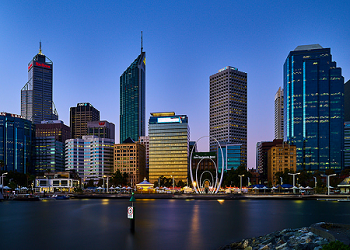 The engineering qualifications available on campus include four Bachelor of Science degrees; one in Mechanical Engineering, one in Civil and Structural Engineering, one in Industrial Automation and one in Electrical Engineering. There is also a Master of Engineering in Industrial Automation. All these qualifications aim to ensure students become proficient technologists and engineers who are ably prepared for the demands of industry.
The engineering qualifications available on campus include four Bachelor of Science degrees; one in Mechanical Engineering, one in Civil and Structural Engineering, one in Industrial Automation and one in Electrical Engineering. There is also a Master of Engineering in Industrial Automation. All these qualifications aim to ensure students become proficient technologists and engineers who are ably prepared for the demands of industry.
EIT has a range of listed scholarships available for local and international students.
Works Cited
“More than 6000 New Jobs in WA Last Month.” PerthNow, www-perthnow-com-au.cdn.ampproject.org/c/s/www.perthnow.com.au/business/economy/job-figures-show-was-economy-is-turning-for-the-better-deputy-premier-says-ng-b88718370z.amp.
Piesse, Emily. “There's Light at the End of the Tunnel for WA Jobseekers.” ABC News, 19 Sept. 2017, www.abc.net.au/news/2017-09-19/wa-jobs-surge-as-mining-downturn-gives-way-to-green-shoots/8956844.
Memristor is a word that you are likely to hear more of in the next couple of years. The burgeoning world of the IoT (Internet of Things) is driving the need for wireless connectivity and synchronisation across devices.
Its name is a hybrid of memory and resistor – and its function is just that.
This particular type of electrical component, found in circuits, is able to keep track of the amount of charge that previously flowed through it. Importantly, they are non-volatile, which means they can retain this memory without a constant power source.
So why does it matter? Memristor technology is being harnessed in the rapidly expanding industry of wearables; from smartwatches and fitness bands to the less widespread smart fabrics and smart glasses.
The wearable devices market has a mammoth expected compound annual growth rate (CAGR) of 69.35% during 2017-2021. Companies such as HP, Intel, Micron and Samsung are pioneers of this investment and development.
The efficiency of the memristor, compared to other electrical networks, was put to the test recently at the University of Michigan. Wei Lu, Professor of Electrical Engineering and Computer Science, is on a mission to create a computer that thinks like a human. The main challenge – ensuring the processors perform logic activities at the same time as memory-based activities.
Enter the memristor - it can do both simultaneously. Lu’s network, known as a reservoir computing system, mimics a neural network in the brain with its own version of neurons and synapses.
Until now, training these networks has been the difficult part, with the process often taking days or months and being incredibly expensive. Information is entered into the systems in the form of questions and answers, they are then programmed to produce the correct answer and slowly minimise error rate.
When memristors are involved much of this training becomes obsolete - the reservoir component is included and doesn’t need to be trained at all. Bypassing the training stage will save significant time and money.
To put it to the test Lu and his team used memristors to identify handwritten versions of numerals. The reservoir systems demonstrated an impressive 91% accuracy rate after minimal training. Lu hopes to develop this technology for use in speech recognition and prediction.
Memristors are being further refined and developed as we speak; it may not be long before they are found on our wrists, embedded in our clothes and even in bedsheets.
Sources:
http://whatis.techtarget.com/definition/memristor
https://www.businesswire.com/news/home/20171229005094/en/Global-Memristor-Devices-Market---Analysis-Trends
https://www.sciencedaily.com/releases/2017/12/171222090313.htm
https://www.researchandmarkets.com/research/h7wdgw/global_memristor
On the 9th of January 2018 a destructive mudslide, in Santa Barbara and Ventura County, California, hit the community of Montecito the hardest. Houses and businesses were literally swept off of their foundations. Days later the death toll had risen to 20 with scores more injured.
100 homes were destroyed and 300 more were damaged. Vehicles were among the losses too.
Freeways and hotels have been closed indefinitely as the community faces an enormous cleanup. Power had been cut off to some areas, and drinkable tap water was not available. Search and rescue teams were very active as people remained missing.
California has just undergone a destructive, dry season that produced many wildfires; these were followed by heavy rains. This dangerous cocktail of events is often followed by mudslides.
With climate change a serious threat, some are thinking California could continue to experience such disasters. Professor of Geography at UCLA, Glen MacDonald, spoke to CBC News about what could become California’s “new normal”.
“What is happening is climate change. We have been experiencing temperatures warming year after year now – this is exacerbating the contrast between our very dry summers and our wet winters. It’s essentially priming the pump for big fires, which are then followed by these landslide events. The new normal? It’s sort of like the normal that we had in the past, but on steroids.”
In 2014, California’s San Bernardino County experienced a mudslide that displaced 2,500 people and left one dead. California has become accustomed to possible mudslides, but it was the unprecedented torrential downpour that caused the latest mudslide.
Engineering around the climate
Demolition workers have begun the process of breaking down boulders that came off of the mountain during the mudslide of the 9th of January.
University Professor Laura Sullivan-Green who works in the Civil and Environmental Engineering department at San Jose University explained how the wildfires in California had a ‘direct impact’ on the mudslide.
Talking to Fox News’ KTVU, she said that California’s Thomas Fire had caused 280-thousand acres of scorched earth. The burned vegetation, mixed with the heavy rains, made the hillsides of Montecito a prime candidate for flash flooding and a mudslide.
The consensus from most experts is that the woes experienced in California are because of civil engineering practices of old. Despite the dangers, even back then, construction in California continued. The situation is similar to that in Mexico City: arguably humans should never have inhabited areas prone to natural disaster.
Mexico City was hit by an earthquake last year, highlighting its unfortunate geographic positioning. This capital city is likely to experience violent earthquakes as it is was built on an ancient lake bed. For more on Mexico City, read our report from last year.
Sullivan-Green explains that other areas of California may also be in danger of mudslides, especially if they too have suffered the triggers experienced by Montecito. She says:
“Making sure that water can drain easily, and sandbagging to prevent erosion are, really, the key things right now. It can take up to two years for the soil to recover significant vegetation, as well as reduce the water-repelling chemical change.”
Encouragingly, research is being conducted at the University of Arkansas. In 2014, a team of researchers were given US$1.4 million to develop a system of remote-sensing technologies. These were designed specifically to help the relevant authorities predict a mudslide, rockslide or similar event in the area of California.
Richard Coffman, the assistant professor of civil engineering, and head of the project said:
“The hazard to infrastructure resulting from wildfires includes the initial damage associated with the wildfire and then secondary effects from the wildfire denuding the soil. To combat these hazards, transport officials typically rely on various maps that document burn severity, soil composition, geology and topography - but these tools do not offer the high spatial and temporal resolution of remote-sensing data.”
California has suffered, but the researchers will benefit as they have yet more data to add to their current studies. It will also assist those civil engineers hard at work figuring out how to protect vital infrastructure in areas where mudslides may simply be unavoidable.
Works Cited
Ktvu. “Environmental Engineering Expert on SoCal Mudslides.” KTVU, www.ktvu.com/news/environmental-engineering-expert-on-socal-mudslides.
McGowan, Matt. “Grant Will Help Researchers Develop System to Assess Risk of Mudslides, Rock Falls.” University of Arkansas News, news.uark.edu/articles/25619/grant-will-help-researchers-develop-system-to-assess-risk-of-mudslides-rock-falls.
cbcnews. “Weather Extremes: California's New Normal?” YouTube, YouTube, 9 Jan. 2018, www.youtube.com/watch?v=8Akqrda6QhU.
Cape Town, South Africa, may become the first modern city in the world to run out of water. This headline is being strewn across news networks around the world. Time is ticking toward ‘Zero Day’ - a day in April when the Cape is set to run out of water.
Cape Town residents are now restricted to 50 liters of water per household per day and this figure is soon to be halved.
Professor Mike Muller, the former Director-General of the Department of Water Affairs and Forestry (1997-2005) released a report in June 2017 named: Understanding the origins of Cape Town’s water crisis. He wrote:
“The water crisis that has confronted Cape Town this summer should be of concern to all professional engineers in the field of water management. How was such a critical situation allowed to develop in one of South Africa’s largest cities?”
The history
Ever since the colonization of the Cape by Dutch settlers in 1652 crippling droughts have been experienced. Between 1699 and 1732 it became clear that the Cape was moderately arid. Some excerpts from the Precis of the Archives of the Cape of Good Hope read:
October 29, 1699: The grain-crop suffering from drought. Rain wished for. Bad harvest feared.
January 29, 1700: The Governor refers to the poor harvest, caused by floods and succeeding droughts; the consequent want of grain here, and the necessity of making provision for supplies.
May 7, 1700: All the farmers are complaining of drought, as the ground is too hard to plough without rain, and the cattle for want of pasture is very poor and dying. Prayer should be made to Almighty God to preserve us from a third bad harvest, as our condition would otherwise be very miserable.
January 13, 1702: The south-easter blowing still (from before New Year, with slight pauses), causing the destructive drought to continue.
The word ‘drought’ is written 15 more times in the first volume of the Precis of the Archives of the Cape of Good Hope. In 1711 there was a drought. In 1713 after five months of no rain it finally came in March. In 1714 drought struck again. In 1725 there is another reference to a severe drought which again would produce a bad harvest.
Farmers had the same problems back then that they have today: devastating droughts followed by incredibly destructive storms and crops that either fail or are poor.
The situation has, however, changed over time - a change which further burdens already stretched resources. The population in the Western Cape has grown exponentially in recent years, exacerbated by migration to this southernmost tip on the African continent. And the city of Cape Town has borne the brunt. There is an estimated metropolitan population of between 3.5 and 4 million people with a population density (back in 2016) of 1,530 people per square kilometer. The population in Cape Town in 1955 was a mere 705,000.
A solution which factors in burgeoning growth is needed urgently. The water shortages today are dire; little seasonal rain in their 2017 winter have seen dam levels fall to desperately low levels – they are currently sitting below 30% and already potentially tainted.
The Eastern Cape’s dams are also in trouble as the drought bites there too. Experts believe that if the Cape experiences three years of seasonal rains they may be back on track.
In the interim what can engineers do to solve the crisis?
Prof Mike Muller goes on to write that if the Cape had wanted to avoid these latest water restrictions the government should have imposed technological ‘interventions’ in a timely manner.
There is a flurry of activity now, but the overarching question is: Can engineering save the Cape from its water crisis in time – enough to satisfy the daily city consumption of 580-million liters?
The Mayor of Cape Town, Patricia De Lille, has acted to contribute to the solution; she has called upon major drilling companies in the country to drill in “prime locations” to access aquifers she says could produce 150-million liters per day.
The drilling engineers will access these ancient water reserves that have been untouched for millions of years, says Mayor De Lille. Engineers and scientists will then ensure the water is potable before introducing it into the water supply. Work has started in the Cape Flats Aquifer.
This is likely to be a short term solution – once the water has been harvested the aquifers may struggle to replenish themselves - especially if the drought continues.
With the conservation of water being key, intelligent water pressure management technology has been implemented in the Cape. It will prove to be an efficient way of preventing damage to existing infrastructure and ensure that people do not use more than is necessary in these tough times. The City of Cape Town put out a statement saying:
“Not only does pressure management generally lower consumption by reducing the rate at which water flows to properties, it also reduces leaks and pipe bursts by better ensuring that pressure remains within levels that the pipework can tolerate, and reduces the rate of loss from leaks and bursts. At all times, careful consideration will be given to ensure minimal disruption to the water supply in affected areas.”
University of Cape Town Future Water Institute’s Dr Kevin Winter spoke to Talk Radio 702 about the aquifers. He believes that if the locals could reduce their water consumption to below 450-million-liters per day, it would be a significant saving. He also suggests that treated effluent get injected into the aquifers to assist with their recharging.
If and when the storms come the storm-water must be trapped and fed into the aquifers too.
Finally and long-overdue, three new desalination plants will be implemented in the Cape. For residents who have been subjected to water restrictions for quite some time now, it may be too little too late, but at least they offer a sustainable solution.
Works Cited
“Drilling on Cape Flats Aquifer Starts as Cape Town Dams Dry up in Drought.” News24, 11 Jan. 2018, www.news24.com/SouthAfrica/News/drilling-on-cape-flats-aquifer-starts-as-cape-town-dams-dry-up-in-drought-20180111.
“EDITORIAL: Parched Cape Runs out of Time.” BusinessLIVE, www.businesslive.co.za/bd/opinion/editorials/2017-10-30-editorial-parched-cape-runs-out-of-time/.
Muller, Mike. “Understanding Cape Town's Water Crisis.” By Mike Muller :: SSRN, 5 July 2017, papers.ssrn.com/sol3/papers.cfm?abstract_id=2995937.
“Precis of the Archives of the Cape of Good Hope : Cape of Good Hope (South Africa). Archives : Free Download & Streaming.” Internet Archive, 1 Jan. 1896, archive.org/details/precisofarchives01capeiala.
http://worldpopulationreview.com/world-cities/cape-town-population/
Nikola Tesla was an electrical engineer, a master of invention, and a technological giant far beyond his years. An electric engineer for the ages. His influence on the engineering industry is continually being recognized in a world where alternative energy is becoming the status quo.
 As his career matured, Tesla would turn into a polarizing figure; many were very skeptical about his belief in what humanity could achieve with electricity.
As his career matured, Tesla would turn into a polarizing figure; many were very skeptical about his belief in what humanity could achieve with electricity.
However, nothing immortalizes Tesla, and highlights his intentions for the application of electricity, more than the products produced by a company founded in 2003 and named after him: Tesla Inc.
Elon Musk, the CEO of Tesla Inc, speaking to HenryFord.org about innovation said:
“The car company’s called Tesla. The reason it’s called Tesla is because we use an AC induction motor, which is an architecture that Tesla developed - and the guy deserves a little more play than he gets in current society.”
Nikola Tesla, in a surreal epiphany, had the idea to design an alternating-current motor and electrical system that would revolutionize the power grid that Thomas Edison - the man that brought the world the incandescent light bulb - had built in the United States.
Tesla’s ideas for how electricity could solve the world’s problems wouldn’t all come to fruition in his lifetime, however, the work he did, paved the way for the kinds of electric-powered technology we know today.
Tesla’s Electrical Future
The founders of Tesla Inc. believe:
“Without Tesla’s vision and brilliance, our car wouldn’t be possible. We’re confident that if he were alive today, Nikola Tesla would look over our 100 percent electric car and nod his head with both understanding and approval.”
Tesla Motors put out their first electric car, the Tesla Roadster, in 2008; it was the first automobile to be powered off of lithium-ion battery cells. They are now manufacturing the Model 3 and rolling it out to their high-paying customers.
Another one of Nikola’s seemingly ‘crazy’ ideas was that everyone should have access to an unlimited amount of energy that could power their homes indefinitely. He was hoping to achieve this with electricity.
In response to this idea of his Tesla Inc. has engineered and debuted two incredible energy storage products; they have released the Powerwall to power houses and the Powerpack for industrial-sized businesses. These ‘batteries’ are a clean, renewable source of energy; they store solar energy harvested by photovoltaic solar cells and are designed to be used in peak times.
The engineer’s voice in the world
Nikola Tesla was an opinionated electrical engineer as well. He wrote many letters to magazines to not only correct them on any inconsistencies, but also to respond to peers in the industry like Edison. If Tesla was alive today he might’ve used Twitter - which Tesla CEO Elon Musk uses as a platform to respond to questions and tweet his opinion.
Tesla’s best letters have been compiled in a book named Very Truly Yours, Nikola Tesla that can be purchased in e-book format or in hard copy.
Nikola Tesla’s life serves as an example of an electrical engineer who had dreams far too advanced to be realized in the era in which he was born. He was a genius who was driven by, but a little overwhelmed by his own ideas. Nikola Tesla said:
“With ideas it is like with dizzy heights you climb: At first they cause you discomfort and you are anxious to get down, distrustful of your own powers; but soon the remoteness of the turmoil of life and the inspiring influence of the altitude calm your blood; your step gets firm and sure and you begin to look - for dizzier heights.”
His legacy lives on in the minds of engineers who are pioneering new inventions to improve the world we live in.
Works Cited
“Elon Musk - Visionaries on Innovation.” The Henry Ford, www.thehenryford.org/explore/stories-of-innovation/visionaries/elon-musk/.
“Tesla.” Tesla, Inc, www.tesla.com/.
Wasik, John F. “Nikola Tesla: the Man Whose Name Lives on in the Tesla Car.” Financial Review, Financial Review, 8 Jan. 2018, www.afr.com/technology/the-man-whose-name-lives-on-in-the-tesla-car-20180103-h0d7yh.
A highway built out of robust solar panels that generate energy throughout the day has actually become a reality thanks to Chinese engineers. The engineers have dubbed it the very first photovoltaic highway the world has ever seen. (Although France opened one of their own back in 2016.)
Regardless, the Chinese opened the highway on the 28th of December 2017, in Shandong, a province in China. The highway involves a 2 kilometer stretch fitted with solar panels which the engineers say will also charge electric vehicles that drive over them through remote charging technology. Buried underneath a layer of transparent concrete and silicon, the photovoltaic cells stay intact whilst cars pass overhead.
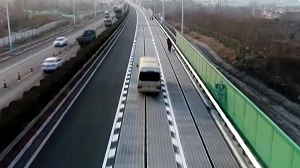
Zhang Hongchao, Chief Scientist at Shandong Pavenergy, the company that built the highway, explained how the cells are kept safe. He said:
“The top layer has good flexibility which can both withstand the pressure of large vehicles and protect the fragile amorphous silicon boards underneath.”
Engineers expect the road to generate 1 million kilowatt-hours of electricity a year through its 10,000 solar panels. The Daily Mail confirmed that the highway cost approximately US$2.7 million.
Thievery closes the highway
The only problem with solar PV installations is that every single solar panel, as part of a group, works together for the highest output possible. If one panel is removed it interrupts the production of electricity.
This is what happened at China’s new, shiny, solar highway. It was reported that during the construction of the solar highway, men were seen taking photos of the road. On the 1st of January, two weeks after the road was opened, a portion of the road had been expertly cut out and stolen. Seven other panels were also damaged in the illegal operation.
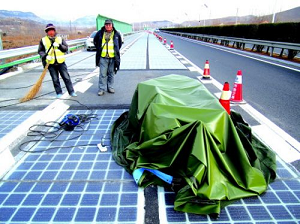
The road has subsequently been closed due to the thievery. Xu Dehao, a construction professional at Shadong Pavenergy, said:
“We can speculate the damage was not done by hand, nor does it appear it was done by a big vehicle. It was more likely done by a professional team.”
The thievery may highlight a worrying trend for future public technology installations.
Interestingly though, the stolen solar panels are set to be replaced at a lower cost - solar panel prices are dropping. For this reason and because China is trying to speedily curb its cities’ air pollution levels solar projects are taking off.
Works Cited
“China's Solar Expressway Meets Light of Day.” China's Solar Expressway Meets Light of Day - Xinhua | English.news.cn, www.xinhuanet.com/english/2017-12/29/c_136858183.htm.
Mailonline, Alex Matthews For. “Cutting-Edge £2million Solar-Panelled Highway Is Targeted by Thieves Less than Two Weeks after It Opened in China.” Daily Mail Online, Associated Newspapers, 7 Jan. 2018, www.dailymail.co.uk/news/article-5243757/Cutting-edge-solar-panelled-highway-targeted-thieves.html.
China’s solar highway shut down by thieves
A highway built out of robust solar panels that generate energy throughout the day has actually become a reality thanks to Chinese engineers. The engineers have dubbed it the very first photovoltaic highway the world has ever seen. (Although France opened one of their own back in 2016.)
Regardless, the Chinese opened the highway on the 28th of December 2017, in Shandong, a province in China. The highway involves a 2 kilometer stretch fitted with solar panels which the engineers say will also charge electric vehicles that drive over them through remote charging technology. Buried underneath a layer of transparent concrete and silicon, the photovoltaic cells stay intact whilst cars pass overhead.

Zhang Hongchao, Chief Scientist at Shandong Pavenergy, the company that built the highway, explained how the cells are kept safe. He said:
“The top layer has good flexibility which can both withstand the pressure of large vehicles and protect the fragile amorphous silicon boards underneath.”
Engineers expect the road to generate 1 million kilowatt-hours of electricity a year through its 10,000 solar panels. The Daily Mail confirmed that the highway cost approximately US$2.7 million.
Thievery closes the highway
The only problem with solar PV installations is that every single solar panel, as part of a group, works together for the highest output possible. If one panel is removed it interrupts the production of electricity.
This is what happened at China’s new, shiny, solar highway. It was reported that during the construction of the solar highway, men were seen taking photos of the road. On the 1st of January, two weeks after the road was opened, a portion of the road had been expertly cut out and stolen. Seven other panels were also damaged in the illegal operation.

The road has subsequently been closed due to the thievery. Xu Dehao, a construction professional at Shadong Pavenergy, said:
“We can speculate the damage was not done by hand, nor does it appear it was done by a big vehicle. It was more likely done by a professional team.”
The thievery may highlight a worrying trend for future public technology installations.
Interestingly though, the stolen solar panels are set to be replaced at a lower cost - solar panel prices are dropping. For this reason and because China is trying to speedily curb its cities’ air pollution levels solar projects are taking off.
Works Cited
“China's Solar Expressway Meets Light of Day.” China's Solar Expressway Meets Light of Day - Xinhua | English.news.cn, www.xinhuanet.com/english/2017-12/29/c_136858183.htm.
Mailonline, Alex Matthews For. “Cutting-Edge £2million Solar-Panelled Highway Is Targeted by Thieves Less than Two Weeks after It Opened in China.” Daily Mail Online, Associated Newspapers, 7 Jan. 2018, www.dailymail.co.uk/news/article-5243757/Cutting-edge-solar-panelled-highway-targeted-thieves.html.
The future of automation is set in stone. It seems clear that industrial robots will replace human beings on the assembly line inside most, if not all, factories in the future. Car manufacturers have already seen many of the tasks on the assembly line replaced by robots - tasks that, once upon a time, belonged to the human employee.
However, Ford Motor Company may have just prolonged the human employee’s stay on the assembly line with new exoskeleton technology.
EksoVest is a joint venture between Ford and California bionics company Ekso Bionics. The wearable technology is designed to decrease the likelihood of injury and fatigue for the assembly line worker. And it makes assembly workers a little stronger, too.
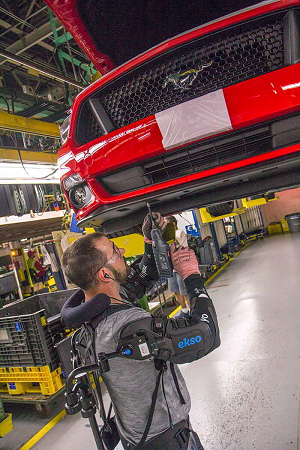
Image source: Ekso Bionics
The EksoVest is attached to the upper body of an employee who performs tasks on the undercarriage of Ford’s vehicles. Overhead work on the assembly line can be quite arduous work when done in long stretches of time.
The EksoVest takes some stresses off of the shoulders, and lessens fatigue. It can also help workers pick heavy equipment up, providing extra lift assistance of up to 15 pounds per arm. What was once science fiction has become science fact.
One of the assembly workers at Ford’s Michigan assembly said:
“Mo job entails working over my head, so when I get home my back, neck and shoulders usually hurt. Since I started using the vest, I’m not as sore, and I have more energy to play with my grandsons when I get home.”
Engineering health and safety
The most common injury on Ford’s assembly line, according to Ford’s ergonomics engineer Marty Smets, is to the workers’ shoulders. As a result, Ekso Bionics, with Ford’s cooperation, tested several prototypes with the assembly line staff until settling on a refined product that would be the best suited ‘wearable’ for its workers.
Russ Angold, the co-founder and chief technology officer of Ekso Bionics told Ford’s media wing:
“The end result is a wearable tool that reduces the strain on a worker’s body, reducing the likelihood of injury, and helping them feel better at the end of the day - increasing both productivity and morale.”
As factories of the future add more machinery, the health and safety of employees on the factory floor is increasingly at risk. Ford is dedicated to keeping the workplace safe for its workers, and now, with exoskeletons, workplace injuries may be avoided.
Ekso Bionics is passionate about lessening injuries across engineering industries. The company reports that the United States spends $21 billion a year on workplace-related injuries. They are continually developing wearables to counteract the effects of hard labour in engineering industries.
Works Cited
Carey;, Nick. “Ford, Ekso Team up for 'Bionic' Auto Workers.” Reuters, Thomson Reuters, 9 Nov. 2017, www.reuters.com/article/us-ford-ekso-workers/ford-ekso-team-up-for-bionic-auto-workers-idUSKBN1D93B0.
“Login.” Ford Pilots New Exoskeleton Technology to Help Lessen Chance of Worker Fatigue, Injury | Ford Media Center, media.ford.com/content/fordmedia/fna/us/en/news/2017/11/09/ford-exoskeleton-technology-pilot.html.
Because they create solutions and solve problems
Mechanical engineers develop processes and they design and implement the moving parts in a range of industries.
They are needed on all stages of a product, from research and development to design and manufacture, through to installation and final commissioning.

Most industries rely on mechanical systems and therefore mechanical engineering is thought to be one of the most diverse of all engineering disciplines.
There are employment opportunities for Mechanical Engineers in a range of sectors including:
- Aerospace – investigating aircraft failures, for example
- Automotive – improving the self-driving mechanisms in vehicles, for example
- Biomedical – developing a mechanical heart, for example
- Construction – designing the fire sprinkler system for a commercial building, for example
- Manufacturing – automating a factory, for example
- Power – finding innovative uses for coal, wind and tidal flow, for example
- Railway – integrating technology to enhance safety on the trains, for example
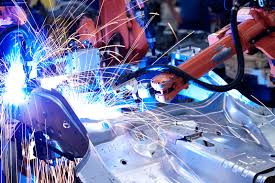
Mechanical engineers can also be involved in the management of people, projects and resources.
Mechanical Engineers are very much in demand today and will continue to remain so as we enter the Fourth Industrial Revolution
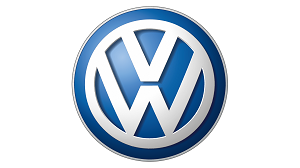
Like water off of a duck’s back, Volkswagen’s Dieselgate controversy has not deterred consumers from buying their vehicles. Autoblog estimates that VW’s worldwide overall sales reached “around 10.7 million cars” in 2017, cementing it as the largest automaker in the world - inching just above Toyota.
The company also set a new record for a car manufacturing company; the company produced six million cars in a year. The Volkswagen Polo was the 7th most purchased vehicle in 2017.
For all its successes, however, it is hard to ignore that VW’s Dieselgate controversy will be a case study of what engineers shouldn’t do within an engineering company - it’s a study in ethics, after all. But how did the story go from unethical engineering practices undertaken quietly, to a story spread across the tabloids?
A publication named Der Spiegler compiled a two-part report, interviewing the students on the events - here is a summary:
Trial + error = a scandal
 Three college students were behind the discovery that led to the Dieselgate scandal. Arvind Thiruvengadam (left) and Hemanth Kappanna (middle) are both from India, and Marc Besch (right) is from Switzerland. The three mechanical engineers had enrolled at West Virginia University in the Center for Alternative Fuels, Engines and Emissions.
Three college students were behind the discovery that led to the Dieselgate scandal. Arvind Thiruvengadam (left) and Hemanth Kappanna (middle) are both from India, and Marc Besch (right) is from Switzerland. The three mechanical engineers had enrolled at West Virginia University in the Center for Alternative Fuels, Engines and Emissions.
They say the revelations were all an accident; one that would go on to cost Volkswagen US$30 billion. It all started in 2012; Volkswagen began boldly running advertisements stating that their turbo diesel engines were “Clean Diesel” engines.
At the same time, the Center for Alternative Fuels, Engines and Emissions was awarded a contract, with budget, for testing diesel cars and their emissions technologies. Eventually taking their studies to California, (a state with the largest number of the so-called environmentally-friendly clean diesel engines from VW), the student engineers went to work.
According to Der Spiegler’s two-part report, the students hired a VW Jetta 2.0 TDI, a VW Passat 2.0 TDI, and a BMW X5, and took them to the California Air Resources Board (CARB). Lab tests reportedly revealed that all cars abided by the legal emission levels. The students then took the cars onto the roads – here they worked out, before long, that the VW Jetta substantially transgressed the legal levels.
The students did an impressive 6,000 kilometers in the cars, traversing San Diego, San Francisco and Seattle. They were continually baffled by the VW measurements - without considering what would go on to define the scandal, the cars’ ‘defeat devices’.
After presenting their findings at a conference in 2014, the deputy head of CARB’s interest was piqued. CARB then continued the research in California, expanding on the students’ research.
The California Air Resources Board, due to their legal framework that holds companies who produce nitrous oxide levels to account, lobbed a host of investigative questions to Volkswagen Group in Germany.
By September 2015, the Environmental Protection Agency had all the facts they needed and were ready to reveal that Volkswagen was unethically underreporting the emissions their vehicles were emitting. To explain how Volkswagen was underreporting their emissions, the Verge put together a very short explainer that reveals how the engineers at VW cheated the system:
Works Cited
Felton, Ryan. “The College Students Who Uncovered VW's Diesel Cheating.” Jalopnik, Jalopnik.com, 24 Oct. 2017, jalopnik.com/the-college-students-who-uncovered-vw-s-diesel-cheating-1819804604.
Oehmke, Philipp. “Out of Nowhere: The Three Students Who Uncovered 'Dieselgate' - SPIEGEL ONLINE - International.” SPIEGEL ONLINE, SPIEGEL ONLINE, 23 Oct. 2017, www.spiegel.de/international/business/the-three-students-who-discovered-dieselgate-a-1173686.html.
A new year has arrived, and with it, new engineering challenges. As 2018 rolled in, so did incredible weather events in both the Northern and Southern Hemispheres.
In the Northern Hemisphere, it has been extremely cold. Days after New York’s governor, Andrew M. Cuomo, revealed a clean energy policy proposal for the state, a winter storm known as a ‘bomb cyclone’ descended upon the East Coast of the United States of America.
Extreme cold
The East Coast has undergone one of the coldest holiday seasons in recent memory. Florida has seen unfamiliar changes in temperatures too. So much so, the state’s iguanas were sent into a state of confusion - they became so cold that they fell out of their trees.
Then, there are the engineering challenges that come with immensely cold temperatures. At Kennedy Airport (JFK) in New York, a water pipe suffered a weather-related break, subsequently flooding a terminal, which led to delays for thousands of travelers.
The Port Authority of New York and New Jersey released a statement explaining that it was the pipe-fed sprinkler system within Terminal 4 that broke at 2 p.m. on Sunday, the 7th of January 2018. The Port Authority’s Executive Director Rick Cotton said:
“What happened at JFK Airport is unacceptable, and travelers expect and deserve better. While the water pipe break that occurred appears to be weather-related, we have launched an investigation into the incident to determine what occurred and why an internal pipe was not weather protected and whether any other failures contributed to this disruption.”
All electrical systems were powered down in the terminal to ensure short-circuits did not occur. 500 flights were canceled due to the pipe break. The baggage claim areas were packed with hundreds of passengers’ bags due to the cancellations.
The bomb cyclone led to three days of flight disruptions for the airport. The Port Authority maintained that “frigid temperatures” would continue to cause “equipment failures and slower than normal operations”.
Extreme heat
In the Southern Hemisphere, sweeping heat waves have sent temperatures soaring. In Victoria, Australia, it was so hot a section of the Hume Highway began melting. Motorists were forced to avoid sticky, melted portions of the road on Friday, the 5th of January 2018.
Temperatures reached 40 degrees Celsius (104 Fahrenheit) on the Hume outside Broadford, causing the bitumen (binding agent) in the tarmac to reactivate and turn to liquid. Alarmingly, the bitumen gets stuck to tires due to the ‘bleeding’ road surface.
Interestingly, melting asphalt is easy to repair due to the fact that only the top layer of the asphalt is affected, which is, in part, why it is used in highway engineering. Moreover, higher grade bitumen can be used to prevent asphalt softening.
However, the disadvantage of bitumen asphalt roads is that greenhouse gases are released once the road begins melting. This has led to some civil engineers to suggest that concrete roadways are better, despite being more expensive.
Climate change effects continue to present engineers with new and unique challenges – 2018 is proving to be no different.
Works Cited
Clark, Emily. “Explained: How Heat Affects Roads, Trains and Planes.” ABC News, 6 Jan. 2018, www.abc.net.au/news/2018-01-06/how-heat-affects-roads-trains-and-planes/9308342.
Silva, Daniella. “Water Main Break, Baggage Pileup at JFK Airport Add to Winter Travel Chaos.” NBCNews.com, NBCUniversal News Group, 7 Jan. 2018, www.nbcnews.com/news/us-news/water-main-break-baggage-pileup-jfk-airport-add-winter-travel-n835431.
“Who, What, Why: When Does Tarmac Melt?” BBC News, BBC, 15 July 2013, www.bbc.com/news/magazine-23315384.
Thank you to all of those who applied for the EIT Outstanding Student Award. Every single student who successfully completes an EIT program of study should be enormously proud of their achievement as it is not an easy accomplishment!
We are aware that the majority of our students are actively employed and have family commitments and so the decision to engage in further study further study can require significant sacrifice and takes a great deal of dedication and perseverance.
We are pleased to announce the winner of the EIT Outstanding Student Award is Andrew Grant, who successfully completed three EIT programs, including the Advanced Diploma of Electrical Engineering. Congratulations Andrew!
Andrew Grant (46) is an International Specialist Electrical Contractor, a business owner and a commissioning engineer. Despite these successes he was looking to remain relevant in our ever-changing world; he recently graduated with an Advanced Diploma of Applied Electrical Engineering. His studies through the Engineering Institute of Technology (EIT) have now won him the EIT Outstanding Student of the Year award for 2017. Read his story HERE.
Runners-Up
We received an unexpected number of applications of very high standard, so we have selected nine Runners-Up this year. A huge thank you to everyone who applied.
Our runners-up are:
Read their stories by clicking on the above links.
2017 EIT Outstanding Student Award Runner-up
Course completed: DIT08 Advanced Diploma of Industrial Data Communications, Networking & IT
Date of completion: November 2017
I had always worked in managerial administration role until four years ago when I applied for a Communications Paraprofessional Apprenticeship/Traineeship. As of this week, I have completed Communications Apprentice/Trainee within the Townsville Communications team. As a Communications Paraprofessional, my role includes installation, testing, maintenance, repairs and commissioning of communications equipment on the Ergon Energy and Powerlink networks such as radio, SCADA, multiplexing, optical fibre, radio, IP in Ergon Energy and Powerlink substations and assets.
Personally, my husband and I are involved with bull riding and team roping (rodeo disciplines) and we both enjoy camping, holidaying, water skiing and snow boarding.
Experience at EIT
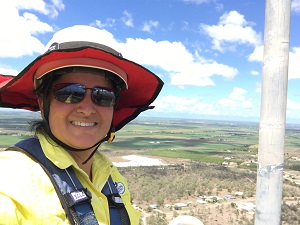 As part of my apprenticeship, I completed an Advanced Diploma in Communications, Networking and IT with EIT. For the most part, the content in the course was applicable to the work I do which made the course more valuable to me.
As part of my apprenticeship, I completed an Advanced Diploma in Communications, Networking and IT with EIT. For the most part, the content in the course was applicable to the work I do which made the course more valuable to me.
There were challenges with working full time, working remotely (with little internet access), home commitments and running out of time for assessments but our Learning Support Officer was very flexible, supportive and understanding of our needs. I was fortunate to do this course at the same time as a few of my colleagues so we provided additional support to each other even though they were based in different locations.
The Moodle site provided a one-stop space where we were able to access all the information we needed including the webinars.
The lecturers were knowledgeable in their fields. The stand out lecturer for me was Brian Hobby. Brian was extremely helpful, responded to queries quickly and always gave constructive feedback and direction.
I was completing my apprenticeship while studying my Advanced Diploma with EIT. I was able to apply the information I learnt while studying to my everyday work and this education helped me to understand the systems that I was working on. We are increasingly working with IP systems and the modules that covered in this area helped me in understanding how the systems I work on operate.
EIT in the workplace
In terms of career advancement, I believe my overall score of 96.52% contributed to me being successful in securing a full time position with the group I’ve been working with during my apprenticeship.
Recently I was offered a full time position as a Communications Paraprofessional with Ergon Energy so over the next 5 years I will be applying my education from my diploma to our protection systems, SCADA, IP systems and radio network. As technology evolves so quickly, I will be in a role where I will be constantly learning and training in new things. In terms of education, in the future I would like to complete more study in the field of electrical and engineering. As for my career, I look forward to a long and rewarding career with Ergon Energy.
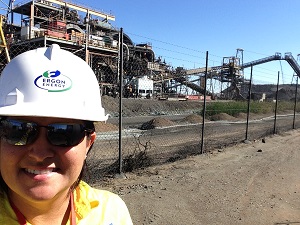
Blog - Steve Mackay
EIT's Technical Director, Steve Mackay, enjoys keeping his blog up-to-date with useful tips and current industry matters for his fellow colleagues. He has a loyal and expanding following base reaching over 300,000 people around the world.
Student Stories
In this section you have the opportunity to read and listen to EIT students talking about the reality of the programs. Discussions are wide-ranging and include information about the study commitment required, the value of the qualification in their careers, the relevance of the subject matter, future pathways, and more. They provide valuable feedback for you to take into account before you decide to join one of our programs.
Career Information
Latest career information including industry research, podcasts, blogs, life hacks and general information about how you can make the most out of your career.
Education
Here you will find out more about the latest trends and developments within education worldwide, along with some helpful articles regarding study tips and keeping on track with your studies.
Developments
The latest innovation and inventions from the world of engineering can be found here. Learn about advances in technology and how they can make a real difference within your industry.
Announcements
Keep up to date with the latest announcements from the Engineering Institute of Technology. In this section you can read more about new courses, new recognition from professional bodies, our Excellence in Teaching Award, upcoming free webinars and much more.
Monthly Update
We understand that you may not have time to read all the articles that we post, so our monthly update gives you access to some fascinating articles which cover the best of the months news in a compact format.
